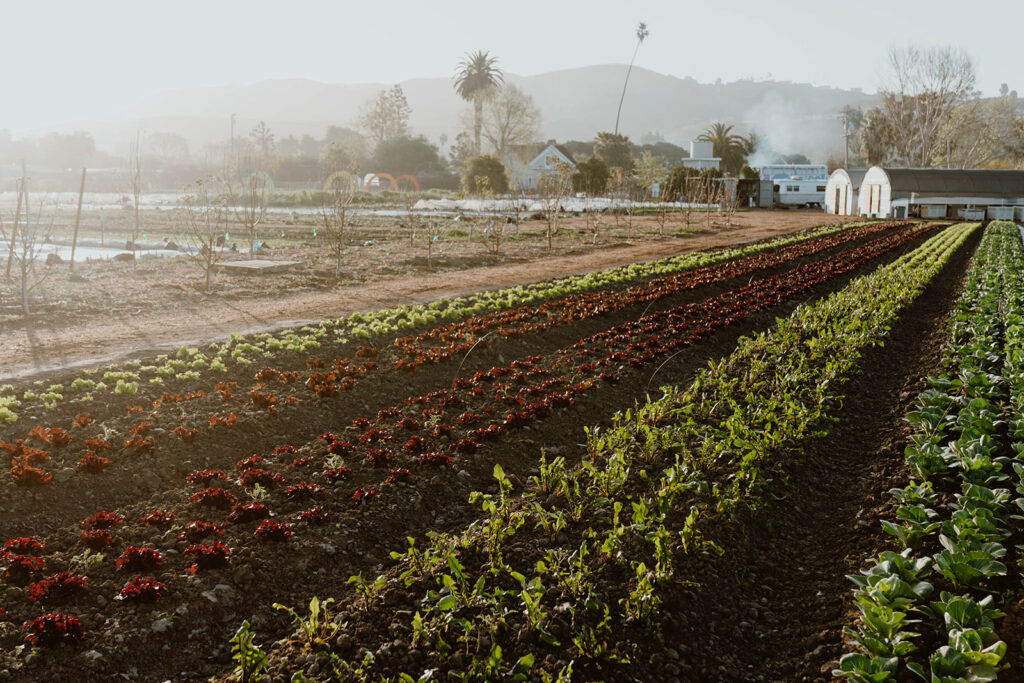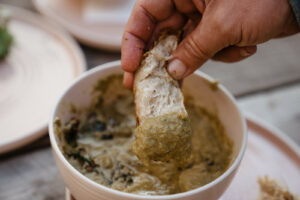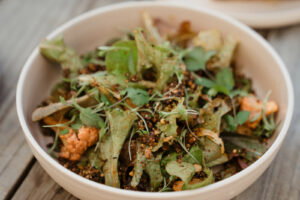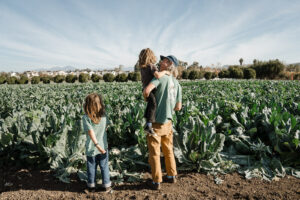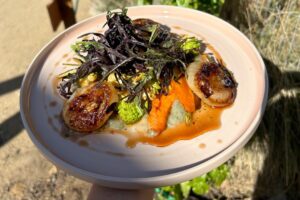Welcome to the Harvest Guide, a comprehensive guide to (almost) every fruit and vegetable we grow on the Farm. In every section, you’ll find a short history of how the vegetable or fruit transformed from its wild origins to the beautiful, flavorful version you see today, as well as notes about the item’s nutrition and flavor profile. The Harvest Guide also offers guidance on how to store the item until you’re ready to use it, tips for cooking and preparing it, and suggestions for how to best bring out its unique taste and texture.
Alliums
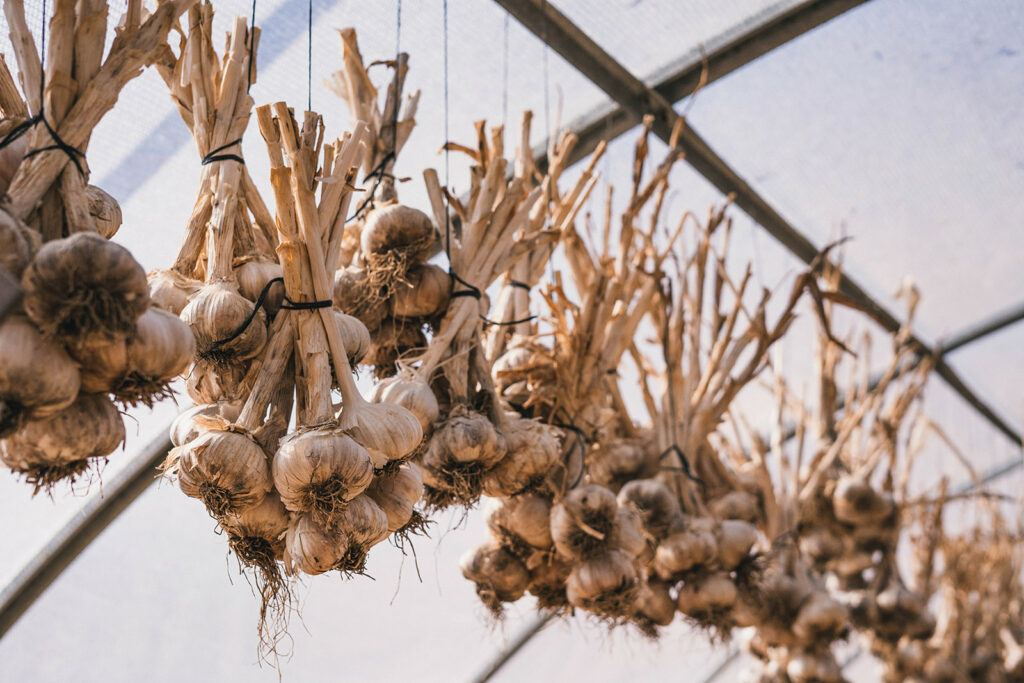
One of the world’s oldest food sources, vegetables in the allium family include all varieties of onions, as well as garlic, leeks, and chives.
SEASONAL IN SOUTHERN CALIFORNIA
PLANT: September through June
HARVEST: January through December
HISTORY
Believed to be a staple of the prehistoric diet, alliums likely originated in the region between central Asia and the Middle East; mysteriously, some varieties are native to North America, as well. Easy to grow, transport, preserve and store, alliums were not only a staple of ancient diets but also a symbol of longevity and the afterlife. Their antimicrobial, antifungal, stimulant and diuretic properties also made alliums useful in early medicine—they are mentioned in texts from Egypt, Greece, India and China as a curative for impotence, scorpion bites, heart disease, lack of energy, and the Black Plague. Spread throughout the Western world by both conquerors and traders, leeks were carried to North America by English settlers, and garlic followed during later waves of European immigration.
PREPARATION
All varieties of alliums come into their own when slowly cooked over low heat, which allows their sugars to caramelize and their fibers to break down. The lighter flavor of shallots and leeks pair well with poultry, pork, eggs, and dairy, while the heavier flavors of onions and garlic complement rich and hearty dishes. Small varieties such as Cipollini and Torpedo onions are delicious when roasted, glazed in balsamic or sherry vinegar, and sprinkled with herbs such as thyme or rosemary. Chopped chives are a bright and piquant garnish for soups, dips, potatoes, egg dishes, fish and other seafood.
COOKING
Finely chop shallots and/or leeks and cook slowly in plenty of olive oil over medium heat, until they are fragrant, broken down, and deep golden-brown in color. Add salt, pepper, and a splash of sherry vinegar, and keep cooking over low heat until liquid has thickened. Toast several slices of crusty bread and spread with goat cheese or ricotta. Spoon shallot/leek mixture over the cheese spread, top with fresh, ripe tomato slices, and sprinkle with chopped chives and, if desired, a pinch of grated lemon zest.
PRO TIPS
If serving alliums raw, soak slices in hot water to mellow their pungency.
Artichoke
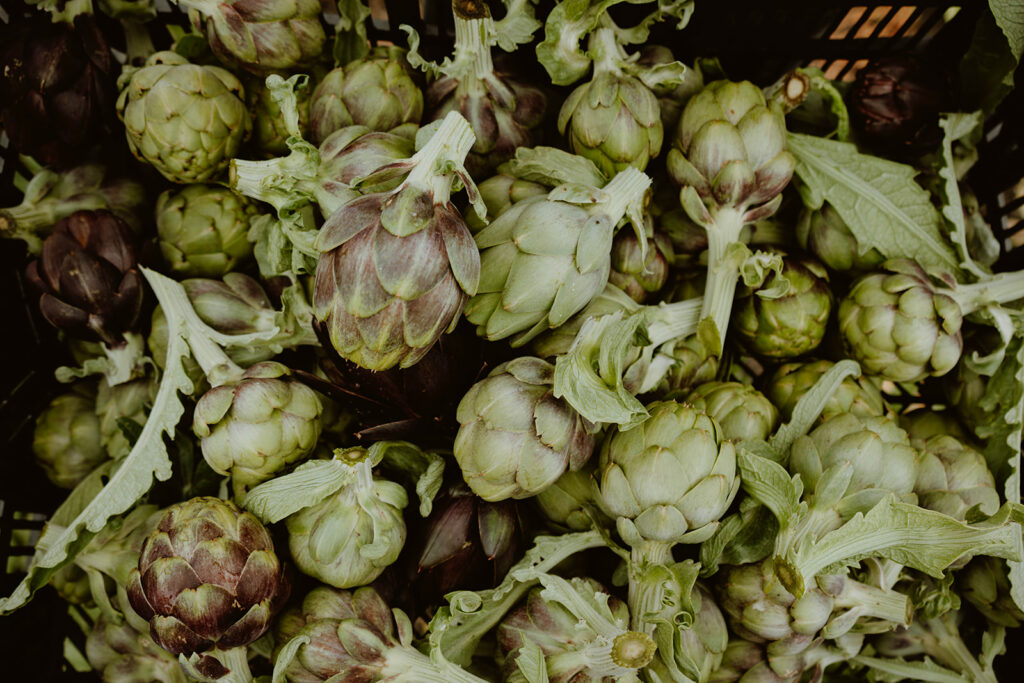
A domesticated variety of an edible thistle, the artichoke is a large, spreading plant with an edible flower bud. The base of the petals yield a creamy, slightly bitter “meat” that grows more plentiful toward the heart of the flower. Considered an icon of California cuisine, the artichoke is not only a seasonal delicacy but the center of many food and cultural festivals, including one that crowned Marilyn Monroe as the first official California Artichoke Queen in 1949.
SEASONAL IN SOUTHERN CALIFORNIA
PLANT: September through January
HARVEST: March through April
HISTORY
While its origin as a food source is shrouded in mystery, there is evidence of artichokes being farmed in Sicily during the heyday of ancient Greece. Farmers in Spain and Northern Africa continued to improve the artichoke through cultivation. By the 16th century, the artichoke had been embraced in French, Italian, and even English cuisine. The artichoke was brought to the United States in the 19th century by Spanish and French immigrants, leading to its cultivation in both Louisiana and California. By the 1920s, the artichoke was a coveted delicacy throughout the country, with demand so great that the mayor of New York City banned them for a brief period.
NUTRITION
Artichokes are a good source of vitamin C, folate, magnesium, and fiber.
STORAGE
Seal unwashed artichokes with a damp paper towel in an airtight plastic bag. Store in the refrigerator for up to 7 days.
PREPARATION
While the classic preparation for artichoke is to steam lightly, then dip in melted butter or mayonnaise, there are many other ways to enjoy this vegetable. Artichokes can be baked or roasted with a filling of grain, seeds, cheese, or meat. Sectioned artichokes can be added to warm or cold salads, pasta, pizza, and dips. Halved or quartered artichokes can be poached or braised in aromatic liquid, fried into tempura, or grilled and served with a tangy dipping sauce.
COOKING
Peel the artichoke stem and cut away tough outer leaves. Trim away pointed ends of remaining leaves, and slice artichoke in half. Rub the cut surface immediately with lemon juice to prevent oxidation, then remove the fuzzy choke from the center of the head. Arrange halved artichokes on a baking sheet and place a clove of garlic in the center of each halved artichoke. Add capers, chopped herbs, or feta cheese, if desired. Drizzle with olive oil and season with salt and pepper, then roast at 400 degrees until edges are brown and crisp.
PRO TIPS
The stems of artichokes are often edible, and taste just like the heart. To test its edibility, peel the stem with a knife, cut off a small piece, and taste. If it is not bitter, cook along with the rest of the artichoke.
Arugula
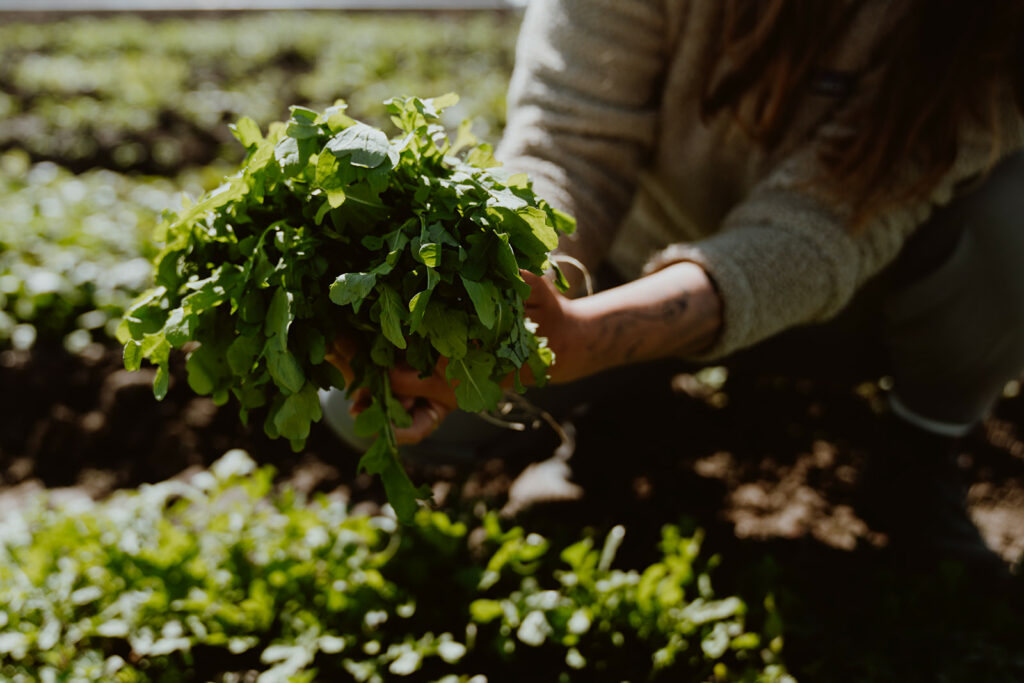
This wild leafy green, also known as “rocket,” was used in Mediterranean kitchens for centuries, yet was relatively unknown to American eaters until the 1990s. As part of the mustard family, it has a peppery bite with both sweet and bitter undertones. This complex flavor, along with the green’s versatility, made arugula an instant hit for home cooks and professional chefs.
SEASONAL IN SOUTHERN CALIFORNIA
PLANT: January through December
HARVEST: January through December
HISTORY
For thousands of years, arugula was widely used for both culinary and medicinal purposes. Along with being used as an anesthetic and as an aphrodisiac, arugula was eaten on a daily basis in Italy and featured in traditional recipes from France to the Middle East. For Jewish groups around the Mediterranean region, arugula was the standard bitter green on Passover plates.
NUTRITION
Arugula is an excellent source of vitamins A, B6, C, and K, as well as folate, calcium, iron, magnesium, phosphorus, potassium, and manganese. Its high nutritional content is linked to diabetes management, cancer and osteoporosis prevention, and cardiovascular health, as well as improving vision, digestion, and immune response.
STORAGE
After rinsing arugula leaves thoroughly, spread on towels or spin until very dry, then pack loosely in a plastic bag with a layer of paper towels to absorb moisture. Arugula will stay fresh in the refrigerator for about a week.
PREPARATION
Arugula is a truly versatile vegetable that can be eaten as a salad green, sauteed like collards or kale, and even used as an herb. While the classic method of serving is with fresh mozzarella and ripe tomatoes, arugula leaves can also be tossed into any stir-fry just before serving, added to pizzas or sandwiches, or substituted for basil in an extra-spicy pesto.
COOKING
Combine arugula with warm roasted or grilled broccoli—toss until arugula is wilted. top with pine nuts, raisins, and shaved Parmesan cheese, and drizzle with a warm dressing of olive oil, lemon juice, and anchovy paste.
PRO TIPS
Younger arugula balances its peppery flavor with a sweeter taste, while more mature leaves have a bitterness similar to dandelion greens.
Carrots
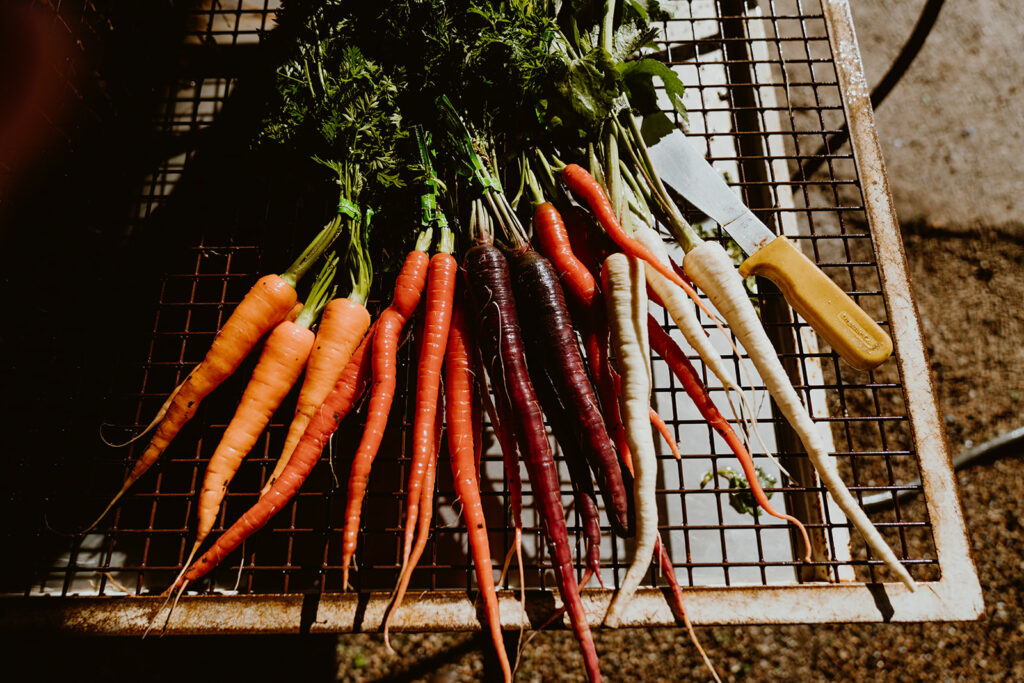
Perhaps the most recognizable vegetable in the world, carrots are known for their kid-friendly sweetness and crunchy texture. While it is prized today for its bright orange root, carrot leaves and seeds offer an herbaceous flavor similar to its related plants such as dill and parsley.
SEASONAL IN SOUTHERN CALIFORNIA
PLANT: September through June
HARVEST: January through December
HISTORY
Domesticated from a wild plant native to Persia, carrots were originally grown for their leaves and seeds. Over time, the plant was selectively bred for a larger taproot, which became popular in the kitchens of ancient Rome and early Europe. Each century spread the carrot farther around the globe, from the Mediterranean and the Middle East to India and China. The orange carrot is fairly new, in terms of the vegetable’s history.
NUTRITION
The bright orange color of carrots comes from a high concentration of beta-carotene, an antioxidant that the human body processes into Vitamin A. Carrots are also rich in vitamin K1, potassium, and fiber.
STORAGE
Snip off leaves about ¼ inch from the top of the carrots, clean off any soil, wrap in a damp cloth or paper towel, and store in an unsealed bag or container in a refrigerator crisper for up to 2 weeks. Avoid cutting the daikon before storing, as the potent smell will spread throughout your refrigerator. Well-dried leaves can be stored for up to a week.
PREPARATION
The bright colors and sweet flavor of carrots have made them a popular choice for every preparation you can imagine. An essential for crudite plates, raw carrots can also be grated, sliced, pickled, and juiced. Their firm texture stands up well to roasting, stewing, frying, or dehydrating. When steamed and mashed, they have a pulpy texture that makes for perfect baby food and is easy to add to baked goods.
COOKING
Peel carrots and chop into bite-size pieces, then add to a large saucepan and cover with water. Simmer until carrots are fork-tender. Add two spoonfuls of butter and two spoonfuls of sugar or another sweetener, along with salt, pepper, and a savory spice mix like vadouvan or garam masala. Cook on low heat, stirring occasionally, until the liquid has thickened into a glaze. Top with finely chopped carrot tops or other herbs, and serve warm.
PRO TIPS
Don’t discard carrot tops. Put cut carrots tops into rice to add color and texture. Upcycle the carrot tops by making a homemade pesto.
Cilantro
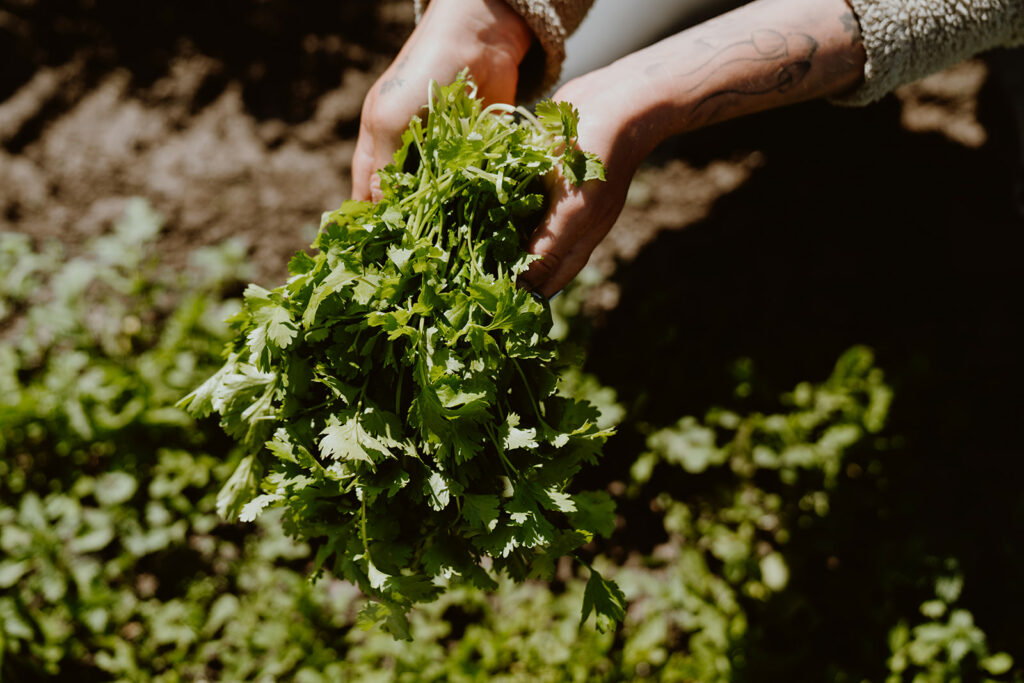
Cilantro, also known as coriander, Mexican parsley or Chinese parsley, is a member of the parsley family, native to the southern Mediterranean. While its taste is a matter of controversy, cilantro’s bright flavor with sage, parsley and citrus notes is indispensable to several beloved global cuisines.
SEASONAL IN SOUTHERN CALIFORNIA
PLANT: September through June
HARVEST: January through December
HISTORY
Cilantro is believed to be one of the first herbs used by humankind, with records of its use as far back as 5000 B.C. Mentioned in early Sanskrit writings, cilantro is a mainstay of Indian and Central Asian cooking; large amounts of the leaves are used to add depth of flavor to cooked dishes, while the seeds are ground for use in the spice blend garam masala. The Romans spread cilantro throughout Europe, and it was one of the first herbs to arrive in the Americas.
NUTRITION
Cilantro is rich in vitamins A, C and K, as well as calcium, potassium, iron, magnesium, and manganese. Cilantro also boasts antibacterial properties and has been used for both insomnia and anxiety relief in traditional medicine.
STORAGE
Cut off the ends of cilantro stems, place in a glass of water, and store in the refrigerator for up to 3 weeks.
COOKING
Delicate cilantro leaves are typically used raw or added to cooked dishes right before serving. Torn fresh cilantro is a bright topping for tacos, enchiladas, and other Mexican dishes, as well as Indian and Thai curries, Moroccan tagine, and a variety of Middle Eastern dishes. It is a welcome addition to condiments such as chutney, salsa, and pesto. Cilantro pairs well with vegetables and fruits such as tomato, avocado, cucumbers, cauliflower, and spinach.
Cucumber
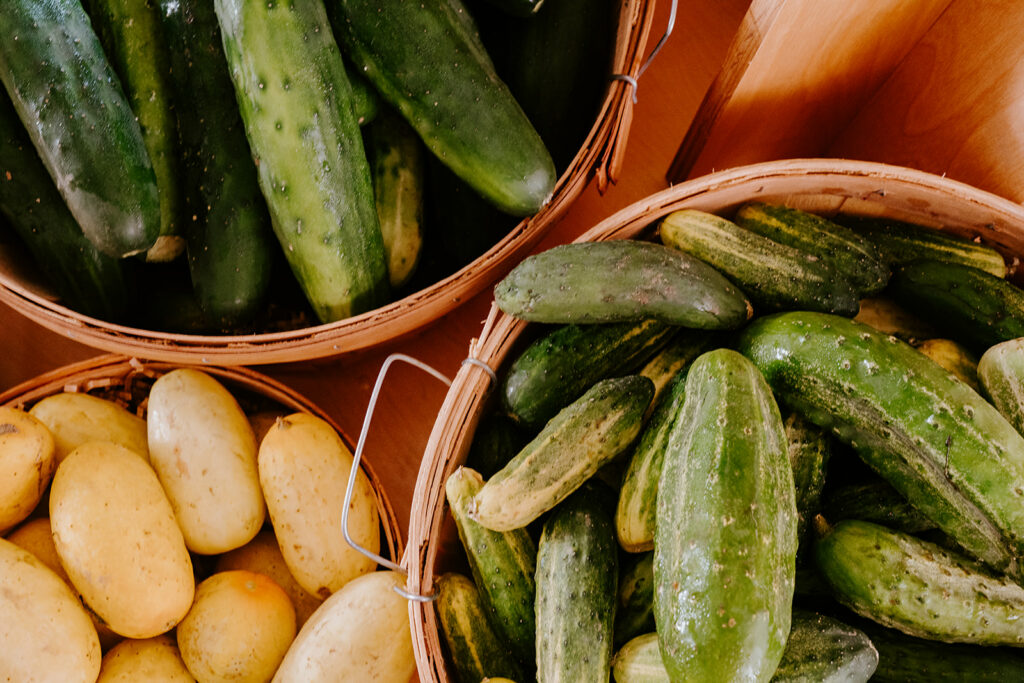
One of the world’s most ancient foods, the cucumber has been bred from a bitter vining gourd into a juicy, cooling vegetable with an herbaceous sweetness.
SEASONAL IN SOUTHERN CALIFORNIA
PLANT: February through September
HARVEST: May through October
HISTORY
Native to India, the cucumber has been grown as a food source for over 3000 years. A staple of the ancient Egyptian diet, the cucumber was also used to make liquor by cutting a hole in the ripe fruit, mashing the inside with a stick, plugging the hole, and letting it ferment. The cucumber has long been a favorite of royalty—the Roman emperor Tiberius ate cucumbers every day, and Catherine of Aragon, the first wife of King Henry VIII, demanded them as well. Cucumbers were brought by Columbus to the New World, first to Haiti and later to the Americas. By the time of American colonization, eight varieties of cucumbers were being grown in the United States. For a brief period in the 18th century, medical journals warned that it was dangerous to eat uncooked cucumbers. However, by the 19th century, cucumbers had made a comeback, thanks in part to the newly formed Heinz company adding cucumber pickles to their product list.
NUTRITION
Thanks to their high water content, cucumbers have a lower concentration of nutrients than many vegetables. That said, they are a good source of vitamins A and C, iron, and calcium, as well as various antioxidants.
STORAGE
Wrap unwashed cucumbers in a dry towel, seal in a plastic bag, and store in the refrigerator crisper for up to 2 weeks.
PREPARATION
While cucumbers are mainly used raw in salads or pickled, they are also delicious when grilled and served with herbs, fresh cheese or yogurt, and olive oil. Cucumbers can be juiced, blended into smoothies, or sliced and added to water or seltzer for a refreshing taste. Cucumbers are also popular when spiralized into vegetable “noodles” and used as a replacement for spaghetti in cold pasta dishes. Other uses for cucumbers include blending with green tomatoes into gazpacho, combining with garlic and yogurt for tzatziki, and dusting with chamoy for pepinos locos.
COOKING
Slice cucumbers into rings or small sticks. Toss with salt and let drain for at least 30 minutes. Add to a bowl with thinly sliced red onion, chopped cilantro, and crushed peanuts. Season with a mix of rice vinegar, sugar, sesame oil, crushed garlic, and Korean chili paste. Toss to coat, and serve cold.
PRO TIPS
To remove cucumber bumps (or “burps”) without peeling, simply rub a cloth or vegetable brush along the length of the fruit until cucumber is smooth to the touch.
Dandelion
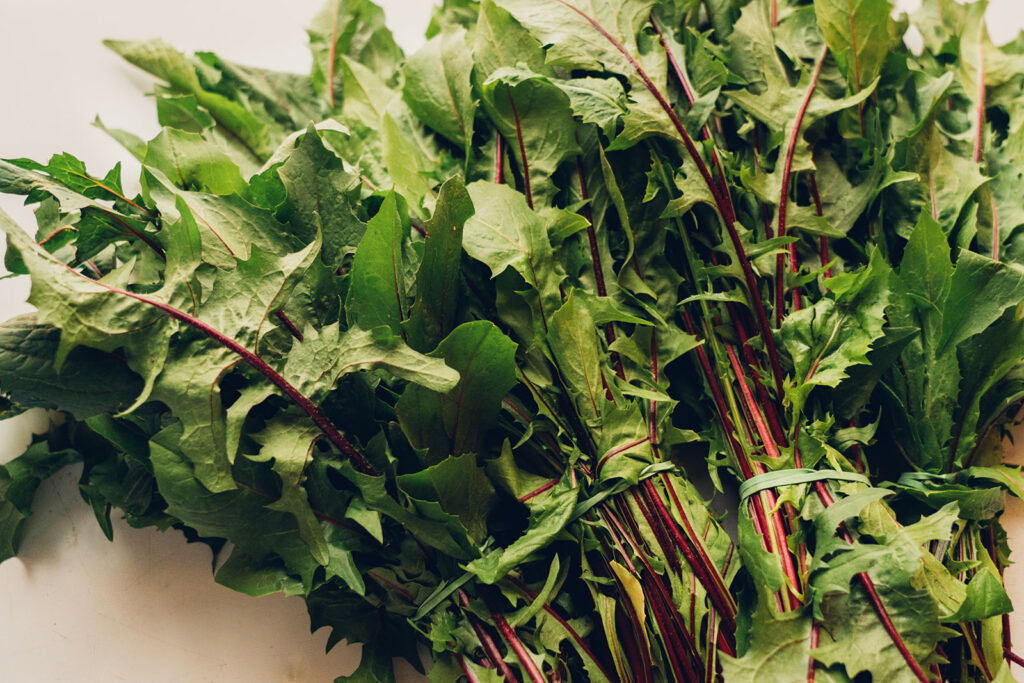
While mainly considered a weed today, dandelion was historically revered as a food with potent health benefits. Their abundant growth and numerous culinary and medicinal uses made them a primary ingredient in everything from stews and salads to pesto, jelly, syrup, and even wine.
SEASONAL IN SOUTHERN CALIFORNIA
PLANT: January through December
HARVEST: January through December
HISTORY
The name of dandelion comes from the French phrase dent de lion, or lion’s tooth, thanks to the leaves’ serrated edges. The plant was also known as pissenlit, or “pee the bed,” thanks to its use as a diuretic. While the plant is native to Eurasia, its aggressive pollination led to it being introduced via European migration to North America, South America, India, and Australia.
NUTRITION
Dandelion is high in vitamins A, C, K and B2, contains more protein and iron than spinach, and includes a sugar compound called taraxacin that stimulates digestion. In traditional Chinese and Native American medicine, dandelion is used to treat stomach and liver conditions, while modern herbalists also use it to heal heartburn, gastrointestinal disorders, inflammation, and diabetes.
STORAGE
Wrap dry dandelion leaves in a lightly dampened paper towel and store in a half-sealed bag in the coldest part of the refrigerator for 3 to 5 days.
PREPARATION
The bittersweet flavor of dandelion leaves is an excellent way to cut the richness of heavier foods like bacon, oily fish, hard cheeses, or avocado. Their bitter flavor also adds dimension to mild flavors such as beans and lentils, grains, and pasta. They are a powerful addition to green juices and smoothies—just make sure to include an apple or grapefruit to help cut the bitterness.
COOKING
Sauté torn dandelion leaves with olive oil and garlic. Transfer to a large bowl, adding lettuce or other greens if desired. Add a scoop of warm white beans, crumbled bacon or pancetta, toasted bread cubes, and a soft poached or fried egg. Toss with more olive oil, salt, and a squeeze of fresh lemon.
PRO TIPS
Taste dandelion greens before using to assess their bitterness. If you find them too bitter, remove stems and blanch greens in a pot of salted boiling water for 1 to 2 minutes, then plunge greens into an ice bath to avoid overcooking.
Dill
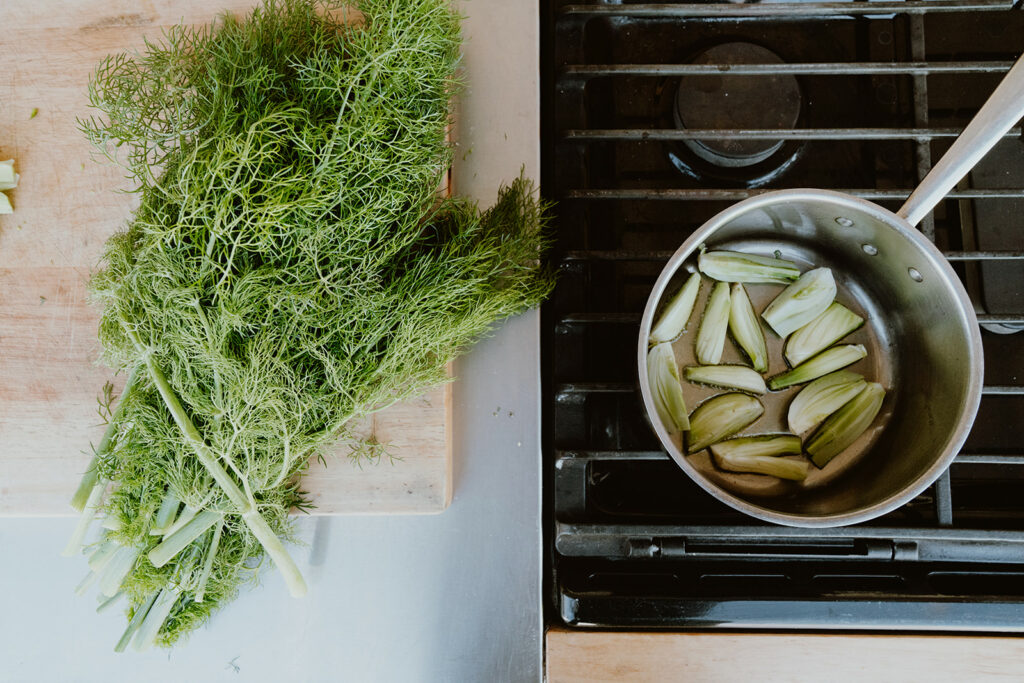
With its feathery appearance and cool, herbaceous taste, dill has long been an iconic springtime herb. A member of the parsley family, dill is native to the southern Mediterranean, though it is today most closely associated with Eastern European and Scandinavian cuisine.
SEASONAL IN SOUTHERN CALIFORNIA
PLANT: January through December
HARVEST: January through December
HISTORY
In the ancient world, dill had a variety of meanings and uses. Ancient Egyptians used dill to ward off witches, while to dill signified wealth to the Greeks and good luck to the Romans, who spread the herb throughout their empire. English immigrants brought dill to North America, where the seeds were often chewed during long religious service to dull the appetite. Strongly associated today with Eastern European and Nordic cultural cuisine, the word dill comes from an old Norse word meaning to soothe or lull.
NUTRITION
Dill is a good source of vitamins A and C, as well as several antioxidants. Traditional medicine uses dill seed to freshen breath, soothe stomach complaints, alleviate colic and indigestion in babies, and stimulate milk production in breastfeeding women.
STORAGE
Snip the ends of dill stems, place in a jar with 1 to 2 inches of water, and store at room temperature for about 2 weeks. Alternatively, lightly spray dill stems with water, wrap loosely in paper towels, and store in a sealed plastic bag for up to 1 week.
COOKING
While very popular as a pickling herb and an ingredient in classic tuna or egg salad, dill is also a natural pairing with spring and summer vegetables, such as asparagus, spinach, tomatoes, and summer squash. It’s light, herbaceous flavor complements the seafood well, especially cold-water fish like herring and salmon, as well as eggs and dairy. It blends well into cold dishes with sour flavors, such as Greek tzatziki and Eastern European borscht.
PRO TIPS
If not using a whole sprig of dill, separate leaves from stem and chop finely to use. 1 tablespoon of fresh dill substitutes for 1 teaspoon dried.
Escarole
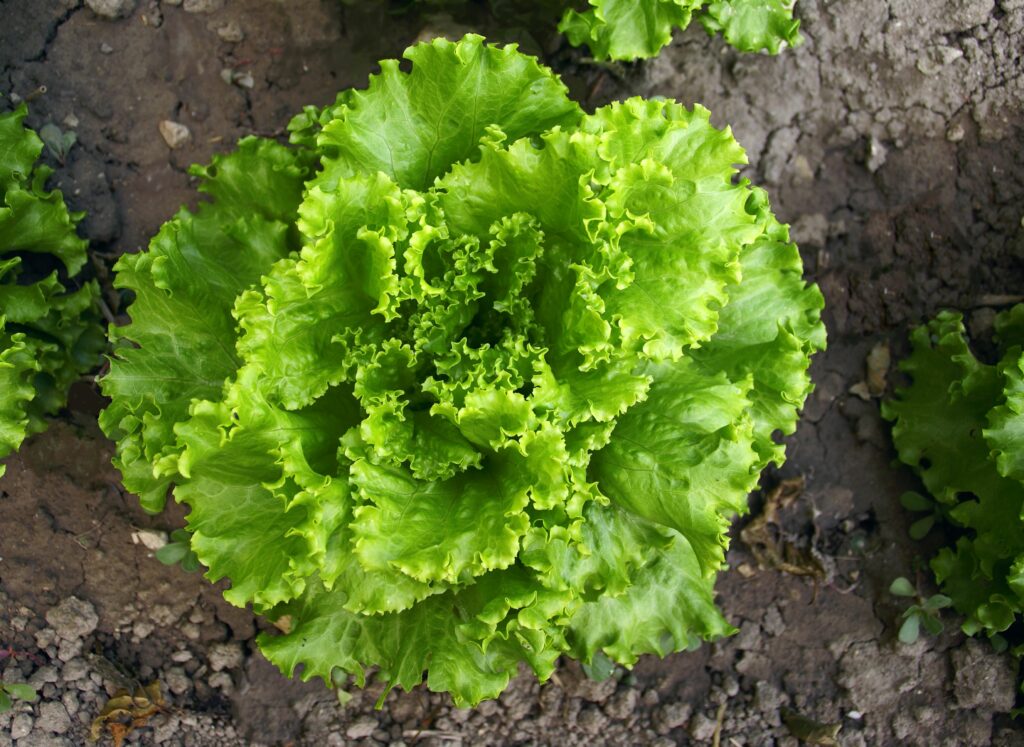
A member of the chicory family, escarole is believed to be native to the East Indies, and as used as a vegetable as early as ancient Egypt. Widely cultivated in both Italy and England from at least the 1500s, escarole was brought to America by European colonists. Escarole’s dark green outer leaves are typically quite bitter, but lighten in color and flavor toward the inner heart.
SEASONAL IN SOUTHERN CALIFORNIA
PLANT: June through November
HARVEST: May through November
HISTORY
Escarole is believed to be native to Sicily. From a very early period it was used as a vegetable by the Egyptians, Greeks and Romans, then spread to the British Isles in the 1500s and was brought to North America by English colonists.
NUTRITION
Escarole is rich in many minerals and vitamins, especially folate. It’s also a good source of B vitamins, as well as vitamins A, C, and K.
STORAGE
Wrap escarole head in a dampened paper towel and store in an unsealed plastic bag in the refrigerator crisper for up to 4 days.
PREPARATION
Escarole greens can be used raw in salads or cooked like other bitter greens. It pairs well with strong, salty flavors such as capers, anchovies, and cured meats and fish. A traditional escarole preparation is the Italian New Year’s Day soup known as straciatella, which combines escarole leaves and a beaten egg swirled into hot chicken broth. It is also delicious when braised slowly and served with stewed beans, pesto or meatballs.
COOKING
Blanch whole escarole leaves in salted boiling water for 2 minutes, then remove and plunge into an ice bath to stop cooking. Let drain and cool, then add a mixture of sauteed black olives, capers, pine nuts and raisins to the base of each leaf. Sprinkle olive mixture toasted bread crumbs and crumbled Parmesan cheese, then roll leaves like a burrito from the base to the tip. Arrange rolled escarole leaves in a baking pan, sprinkle with more bread crumbs and cheese, cover pan with foil, and bake at 375 degrees until toppings are golden brown.
PRO TIPS
If escarole is too bitter for your taste, a little sweetener (such as honey or dried fruit) added to your recipe will help balance the flavor.
Fava Beans
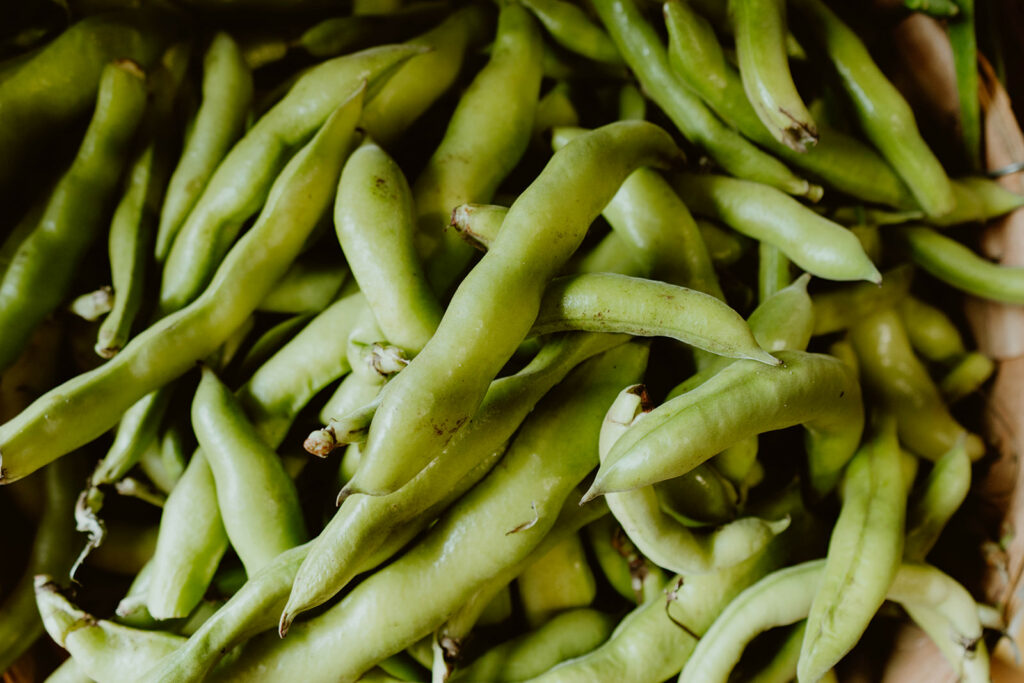
Fava beans are among the world’s oldest cultivated plants, with evidence of playing a part in human diets as far back as 6000 B.C. While many home cooks find their large size intimidating, the rich taste and smooth texture of fava beans have made them a popular seasonal ingredient for fine restaurants around the world.
SEASONAL IN SOUTHERN CALIFORNIA
PLANT: October through December
HARVEST: January through December
HISTORY
The fava bean enjoys a place of honor in many traditional cultures. The ancient Egyptians offered fava beans to the gods, and used them as a temptation exercise to purify priests. It was also believed by Mediterranean people that eating fava beans helped ward off malaria (a belief borne out by later scientific studies). Fava beans were used as the symbol for the Christ child baked into Twelfth Night Cake or King Cake, leading to their general use as a symbol of good luck. To this day, fava beans are the central dish for Sicily’s St. Joseph Day celebration, and Sicilian tradition adds that keeping a fava bean in the wallet will bring good fortune.
NUTRITION
Along with significant protein content, fava beans are an excellent source of vitamins B6 and K, as well as zinc, copper, iron, magnesium and folate.
STORAGE
Store unshelled fava beans in a plastic bag or paper sack in the refrigerator for up to 10 days.
PREPARATION
Traditional uses of fava beans include Italian risotto, Egyptian falafel, Lebanese ful medames, and Indian dal. Steamed fava beans add soft, chewy texture to salads, grain bowls, and pasta dishes. They can also be baked or fried into fritters, puréed into hummus, or grilled in the pods and eaten like edamame.
COOKING
Steam fava beans, then add to a frying pan with plenty of olive oil, salt, garlic, and chunks of spicy sausage. Fry together until the edges of beans and sausage are crisp, then remove and sprinkle with wine vinegar. Serve as a side dish or use as a filling for flatbread.
PRO TIPS
After being shelled and cooked, fava beans will still have a thin, translucent skin around them. Removing this skin before eating will make the texture more palatable and rid the bean of any residual bitterness.
Fennel
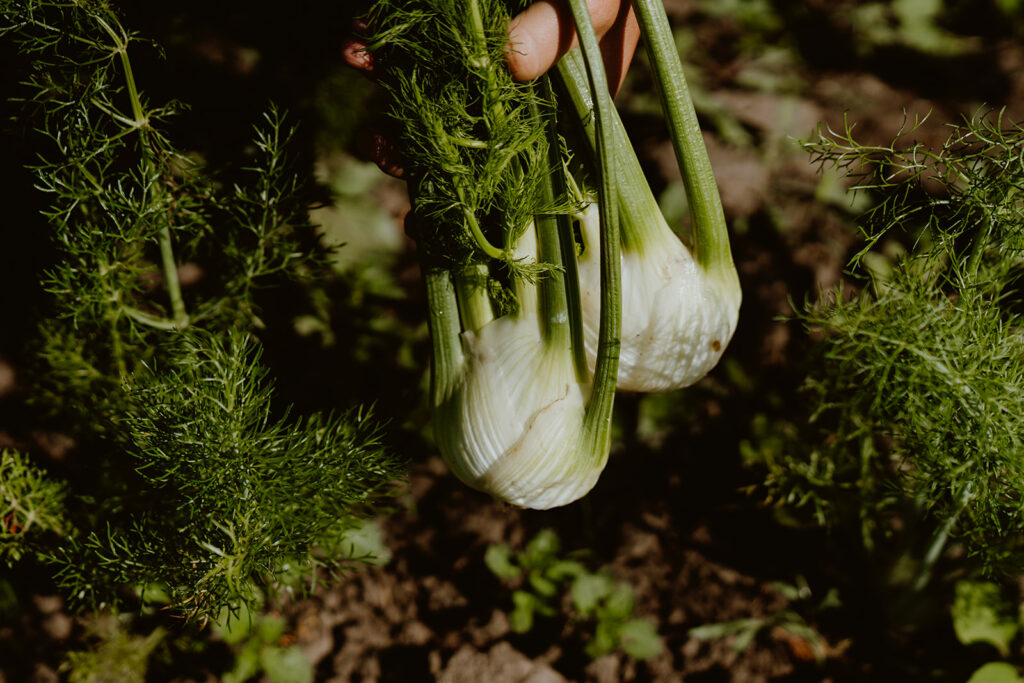
Fennel is a member of the carrot family, related to other aromatic plants such as cumin, dill and caraway. Native to southern Europe, fennel has a sweet, earthy taste with notes of anise.
SEASONAL IN SOUTHERN CALIFORNIA
PLANT: August through May
HARVEST: May through October
HISTORY
Since ancient times, fennel has been used for culinary, medicinal and magical purposes. A common vegetable in Egyptian, Greek and Roman diets, fennel was also used to treat snakebites, suppress appetite, and improve eyesight. Fennel spread quickly around the Western world due to its open pollination. By the Middle Ages, fennel was not only a common kitchen ingredient, but was also hung in doorways to drive away evil spirits. Brought to North America by English settlers, fennel was commonly included in kitchen gardens, though it was mainly used for its seeds. By the 19th century, fennel was used similarly to celery, included in salads, soups, and stews.
NUTRITION
Fennel is a good source of vitamin C, and also contains high amounts of potassium, magnesium, manganese, and calcium. In traditional medicine, fennel has been used as an aphrodisiac and to encourage menstruation and lactation.
STORAGE
Place fennel stalk in a large jar or vase with enough water to cover the base of the bulb, and store for up to 1 week. Alternatively, separate fennel stalks from the bulb, wrap separately in dampened paper towels, and store in sealed plastic bags for up to 4 days.
PREPARATION
Fennel leaves are an aromatic addition to salads, spreads, and dairy or egg dishes, while stems can be grilled with fish, meats and vegetables. Both stems and leaves can be added to cured olives, as well as pickles, sauerkraut and other fermented foods. The crunchy bulb can be sliced and served raw in both fruit and vegetable salads. It can also be segmented and roasted with root vegetables.
PRO TIPS
Try drying fennel stalks in the oven at 200 degrees for about 3 hours, then let cool and continue drying overnight. Use stalks as skewers for grilling fish or meat, or add to flavor stock, broth or infused oils.
Lemon Verbena
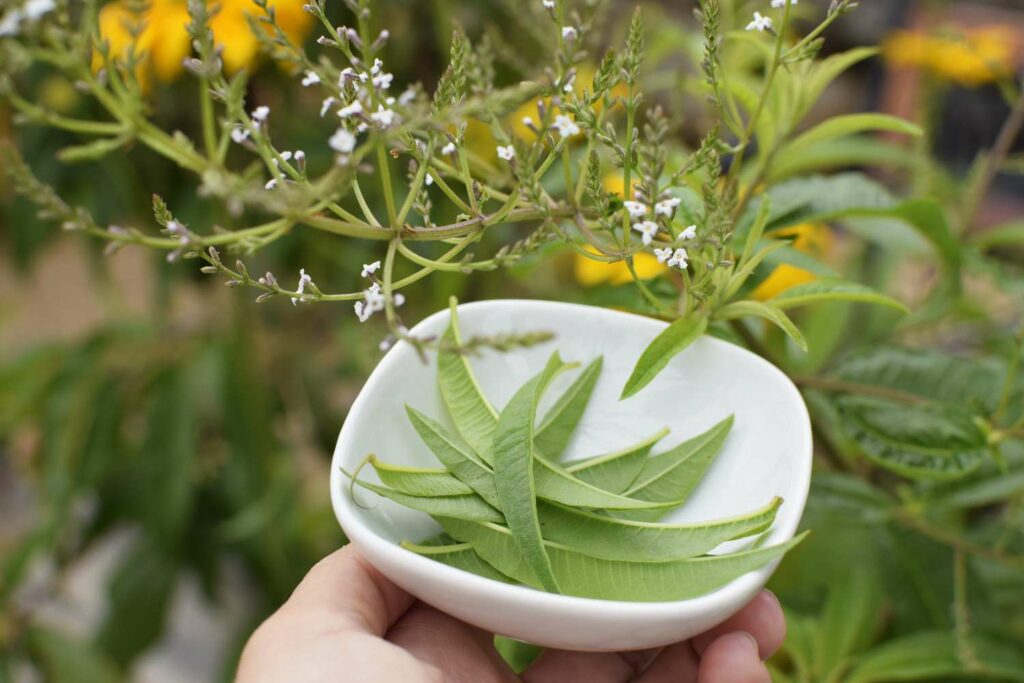
Native to the west coast of South America, lemon verbena is a perennial herb with oil-rich leaves that produce a bright, citrusy flavor. It also goes by the names cedron and yerba Luisa.
SEASONAL IN SOUTHERN CALIFORNIA
PLANT: May through September
HARVEST: January through December
HISTORY
Brought back to Europe by Spanish explorers, lemon verbena was planted in the royal botanical gardens of Madrid. After being shared with botanists in France and Britain in the late 18th century, lemon verbena became a favorite plant of the Victorian era, grown in greenhouses around London, used in fragrant bouquets, and even sewn into women’s dresses.
NUTRITION
Lemon verbena is known for a rich collection of antioxidants and bioflavonoids. One of its primary compounds, luteolin, possess anti-inflammatory and anti-tumor properties that destroy free radicals. The herb is used medicinally to ease digestive disorders, joint pain, insomnia, fever, respiratory and skin issues.
STORAGE
Stand lemon verbena sprigs in a glass of water and keep for up to 1 week. Alternatively, wrap sprigs in a damp paper towel, seal in a plastic bag or jar, and keep in the refrigerator crisper for 2 days.
PREPARATION
Lemon verbena adds a subtle citrusy flavor to fish and poultry dishes, vegetable marinades, and salad dressings. It is also a common flavoring for tea, jelly, syrup, whipped cream, and liqueur, and is a main ingredient in potpourri.
PRO TIPS
Separate desired number of leaves from stem and chop finely or use whole. 1 tablespoon of fresh lemon verbena substitutes for 1 teaspoon dried.
Lettuce
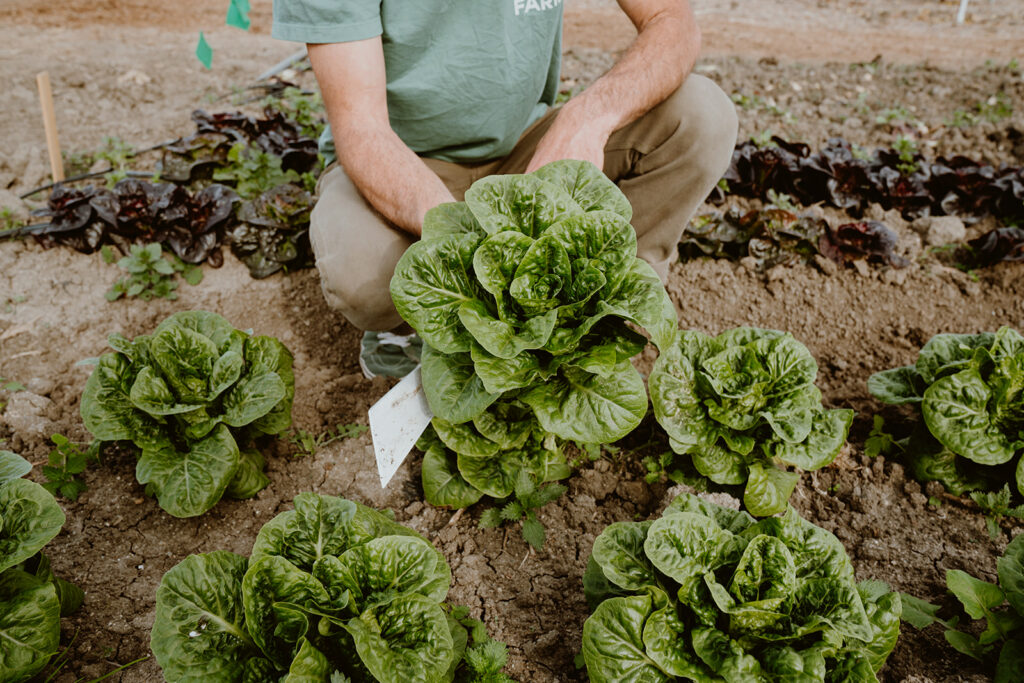
While in ancient times, lettuce was used only for the medicinal value of its seeds (the leaves were considered too bitter for human consumption), it is likely the most ubiquitous green vegetable in the Western world today. The three main categories—head lettuce, loose-leaf, and cos/romaine—all offer a light taste, crisp texture, and soft yet firm structure.
SEASONAL IN SOUTHERN CALIFORNIA
PLANT: January through December
HARVEST: January through December
HISTORY
Lettuce was first grown by ancient Egyptians as an offering to the gods. This use was passed along to the cultures of ancient Greece and Rome, who included lettuce in the origin stories of their deities. In 86 A.D., Roman emperor Domitian began serving lettuce salads at feasts to stimulate the appetite and encourage digestion. This led to Roman farmers developing many other varieties of lettuce, including the red-leaf varieties common today. More cultivars were created throughout the Middle Ages, and their ease of growth led to a rapid spread throughout the civilized world. By the 1800s, seed catalogs had begun an unscrupulous practice of renaming common lettuce varieties to trick farmers into thinking they were buying several different seeds. This, along with the subtle distinctions between varieties, makes it challenging for seed historians to trace true heirloom lettuces.
NUTRITION
While the nutritional value varies with the specific cultivar, lettuce generally is high in vitamin A, C, and K, as well as folate, calcium, magnesium, and potassium.
STORAGE
Submerge the whole lettuce head in fresh cold water, rinse thoroughly, then dry in a salad spinner until leaves are barely damp. Cover lettuce head with a paper towel to absorb moisture, and store in a half-sealed or perforated plastic bag in the refrigerator crisper for up to 5 days.
PREPARATION
Despite being best known for use in raw salads, sandwiches, and wraps, lettuce is also a handy addition to soups, stir-fry, dal, juices/smoothies, and even pesto or chutney. Well-structured leaves with firm stems can be cooked on the grill, or used as cups to hold ground meat, dip, or other fillings.
COOKING
Slice a firm lettuce variety (such as romaine or oak leaf) down the middle lengthwise, keeping the core intact. (If the lettuce head is very large, slice into quarters.) Brush lettuce sections with olive oil and crushed anchovy, if desired, and sprinkle all over with salt. Place cut side down on a hot grill for 2 to 3 minutes, pressing down to ensure a good sear. Flip and grill the opposite side for another 2 to 3 minutes. Remove from grill and top, if desired, with grated or shaved Parmesan cheese, halved cherry tomatoes, chunks of avocado, and garlic-soaked bread crumbs. Add additional olive oil, lemon juice, and salt, and pepper, and serve warm.
PRO TIPS
Slicing lettuce with a metal knife causes a reaction that encourages discoloration and wilting. To avoid this, tear lettuce leaves by hand rather than cutting them with a knife.
Oregano
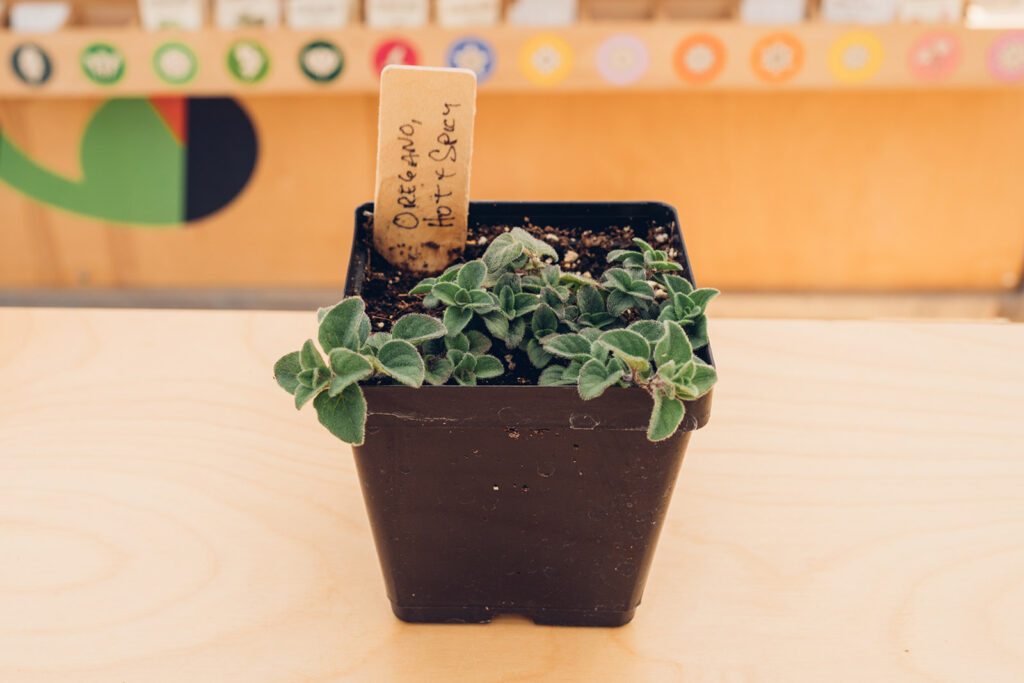
Native to the Mediterranean region and western Asia, oregano is a perennial herb related to the mint family. It is also known as wild marjoram or Spanish thyme.
SEASONAL IN SOUTHERN CALIFORNIA
PLANT: May through December
HARVEST: January through December
HISTORY
Named for Greek words meaning “joy of the mountains,” oregano has long been a flavoring for Mediterranean cuisine. It was readily adopted by the Romans, who spread it throughout the world, including Europe, North Africa, and Asia.
NUTRITION
Along with being an excellent source of vitamins E and K, manganese, iron, and calcium, fresh oregano is highly antibacterial and contains many antioxidants and phytonutrients that help infection and cell damage.
STORAGE
Stand fresh oregano sprigs upright in a container of water for up to 3 weeks. Alternatively, roll in a damp paper towel, seal in a plastic bag or jar, and keep in the refrigerator crisper for up to 1 week.
PREPARATION
Often used in Greek, Italian and Mexican cuisine, oregano has a spicy, pungent flavor. It is a key ingredient in tomato sauces, marinades, and vinaigrettes. It is excellent for adding flavor to grilled meat; you can also add a sprig or two to the inner cavity of chicken or fish before cooking. Oregano is also used as a cure for indigestion and respiratory illness.
PRO TIPS
If not using a whole sprig of oregano, separate leaves from the stem and chop finely to use. 1 tablespoon of fresh oregano substitutes for 1 teaspoon dried.
Parsley

Parsley is a member of the carrot family, native to the Mediterranean region of southern Europe and Asia. Its fresh, astringent taste, known to freshen the breath and stimulate digestion, led to its commonplace use as a plate garnish.
SEASONAL IN SOUTHERN CALIFORNIA
PLANT: January through December
HARVEST: January through December
HISTORY
The name parsley comes from Greek words meaning rock celery because the plant thrives on rocks and walls. The ancient Greeks feared parsley as a symbol of death, thanks to its use as an aromatic to cover the smell of disease and decay. The Romans are credited with the first culinary use of parsley to aid in digestion; parsley was also used at orgies to mask the smell of alcohol on the breath. Some credit Holy Roman Emperor Charles the Great for spreading the use of parsley around the Western world by growing it all over his palace grounds, while others give credit to Catherine de Medici for bringing it from Italy and incorporating it into French cooking.
NUTRITION
Parsley is rich in vitamins A and C, as well as compounds that clear toxins, reduce inflammation, and inhibit histamines and free radicals from the body. Since ancient times, parsley has been used as an antidote to poison, as well as a general tonic for digestion, urinary tract health, and dry hair and skin.
STORAGE
Snip off ends of parsley stems, place in a jar with 1 to 2 inches of water, and store at room temperature for up to 3 weeks. Alternatively, wrap parsley sprigs in a damp paper towel, seal in a plastic bag or jar, and keep in the refrigerator crisper for up to 2 weeks.
PREPARATION
Parsley is a key herb in French cooking and is included with tarragon, chives, and chervil under the term fines herbs. Parsley adding fresh flavor to spring and summer vegetables such as peas, green beans, tomatoes, peppers, eggplant, and summer squash, as well as seafood, poultry, and egg dishes. It is the flagship ingredient in French persillade and Italian gremolata, both sauces that combine parsley with garlic and other ingredients to flavor roasted or broiled meat and poultry. It is also a popular ingredient in green juices, thanks to its cleansing effect and use as a digestive stimulant.
PRO TIPS
If not using a whole sprig of parsley, separate leaves from the stem and chop finely to use. 1 tablespoon of fresh parsley substitutes for 1 teaspoon dried.
Parsnip
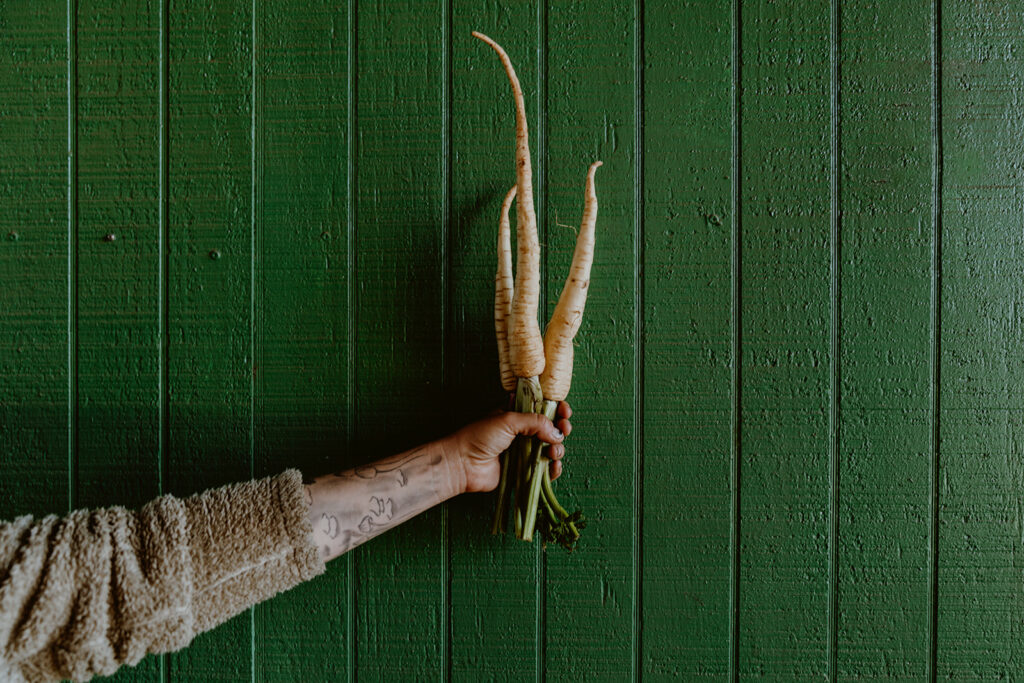
Cultivated since the birth of agriculture, parsnips have been a primary food from ancient Rome to the early days of colonial America. The large, tapering white root is commonly mistaken for carrots or even daikon radish, but its distinctive sweetness made it useful not only as a root vegetable but also as a sweetener before sugar was widely available.
SEASONAL IN SOUTHERN CALIFORNIA
PLANT: November through February
HARVEST: November through March
HISTORY
Before the potato was introduced from the Americas, parsnips were the root vegetable of choice for European kitchens. The Roman emperor Tiberius liked parsnips so much that he accepted them as tribute from his subjects. Brought to North America by French and English colonists, parsnips were quickly adopted by the surrounding indigenous nations.
NUTRITION
Parsnips are a popular substitute for potatoes, thanks to being lower in simple carbohydrates. Their high fiber content makes them excellent for digestive health as well as regulating blood sugar. Parsnips are also high in Vitamin C, folate, and manganese. For all these reasons, parsnips have historically been fed to the elderly, the weak, and those convalescing from sickness.
STORAGE
Be careful when handling greens, as they can cause a reaction to sensitive skin. Parsnips wrapped in a towel or perforated bag and stored in the refrigerator will keep for about 3-4 weeks. Do not wash or peel until just before cooking.
PREPARATION
While the dense flesh of parsnip can take quite a long time to cook, they provide a rich, caramelly flavor when roasted, baked, or fried. In many English-speaking cultures, parsnips are a mainstay of winter holiday feasts. Popular modern methods of cooking parsnips include adding them to mashed potatoes or frying thin slices into chips.
COOKING
Peel and quarter parsnips, then drop into a pot of barely simmering coconut milk spiced with fresh ginger, nutmeg, cardamom, and/or curry powder. Poach until parsnips are almost tender, then remove and add to a pan and sauté with butter and salt. When parsnips are caramelized, add a splash of coconut milk from the poaching liquid, and reduce it until the milk is thickened into a glaze.
PRO TIPS
While most people enjoy the faint aroma of raw parsnips, some people may develop an allergic-like reaction to it. There are no known toxins in domesticated parsnips, and cooking eliminates any negative effects from the smell. If you find the smell of parsnips unpleasant, keep them tightly wrapped until ready to cook.
Peas
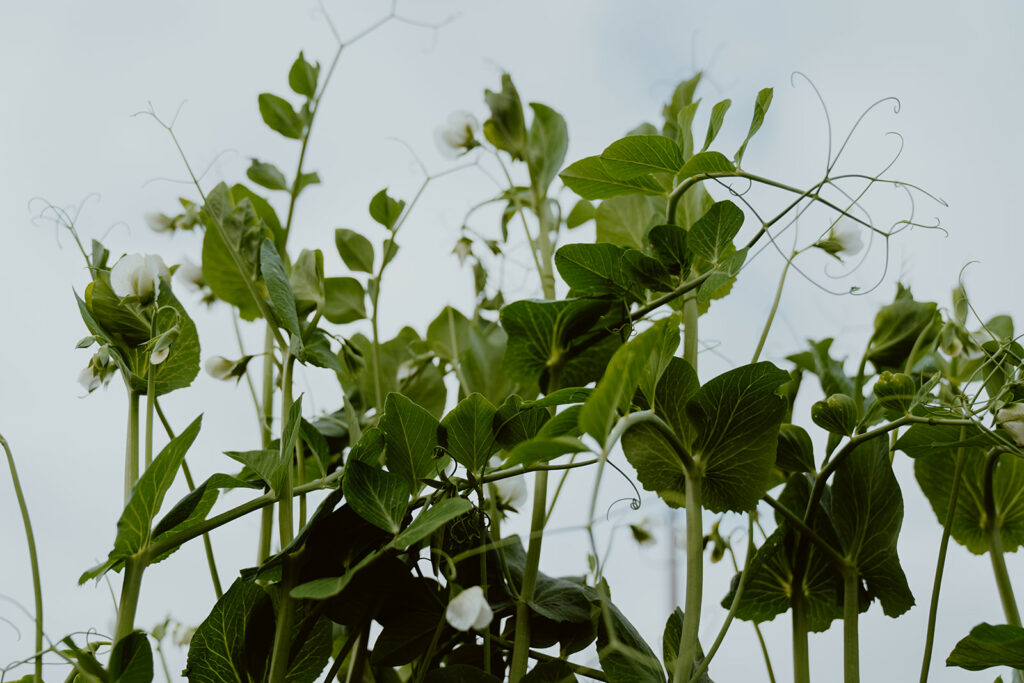
One of the world’s oldest cultivated crops, the pea is a legume that has fostered the development of agriculture and science throughout history. Along with providing reliable nourishment throughout times of famine, peas were the basis of Mendel’s 1856 experiments in genetics, as well as the birth of frozen food preservation in the 1920s.
SEASONAL IN SOUTHERN CALIFORNIA
PLANT: January through December
HARVEST: October through June
HISTORY
Native to the Mediterranean region, there is evidence of pea cultivation dating as far back as the late Neolithic Period. By the Middle Ages, peas were a staple survival crop in Europe, the Middle East, and North Africa. Initially, only the dried seeds were eaten by peasants, but by the early days of modern Europe, fresh green peas were eaten as a delicacy. This led to the development of new cultivars, known as English peas, meant to be eaten fresh. By the 19th century, the modern split pea—green peas with their skins removed to encourage a natural divide in the legume—had become a common kitchen ingredient around the world.
NUTRITION
Peas are an excellent source of vitamin A, B1, and C, as well as folate, iron, and phosphorus.
STORAGE
Store unwashed, unshelled peas in a perforated bag or unsealed container in the refrigerator crisper for up to 5 days. Peas can also be blanched in boiling water for 1 to 2 minutes and then frozen for up to 6 months.
PREPARATION
Fresh peas add a bright pop of sweet flavor and juicy texture to any dish. Add steamed or roasted peas to soup, stir-fry, curry, rice, or pasta, or use as a bed for seafood, chicken, or meat. Peas pair well with creamy dishes such as polenta, chowder, or thick stews, and offer a sweet, fresh counterpoint to rich and salty flavors such as cured meats or cheese. They can also be puréed with garlic and herbs as a side dish or a dip.
COOKING
Toss fresh peas with crushed garlic, olive oil, and salt, then add to a hot frying pan and roast over high heat, turning constantly, until peas are lightly blistered all over. Remove from heat and sprinkle with finely chopped herbs, a splash of lemon juice, and crumbled fontina cheese, if desired.
PRO TIPS
Shelled pea pods can be added to vegetable stock or braising liquid for a boost of flavor and nutrition.
Radicchio
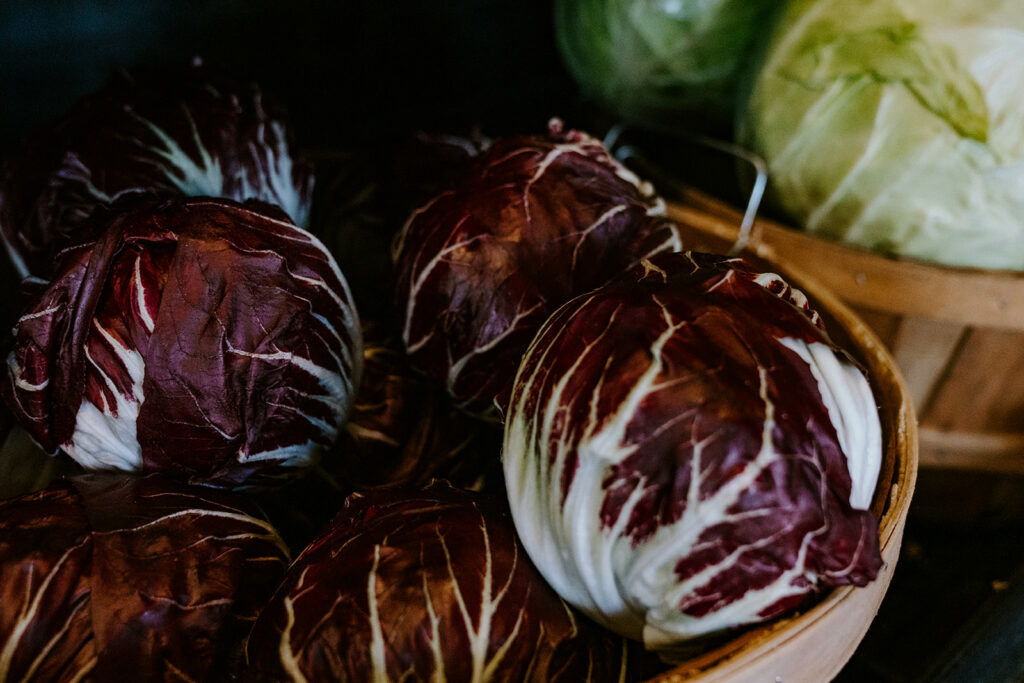
Sometimes known as Italian chicory, radicchio is a common addition to salad mixes for its beautiful coloring and piquant bitter flavor. Along with its culinary uses, radicchio has long been used medicinally as a blood purifier, a liver tonic, and even an ingredient in cosmetics to soothe irritated skin.
SEASONAL IN SOUTHERN CALIFORNIA
PLANT: January through December
HARVEST: November through May
HISTORY
Descended from wild chicory plants, radicchio was first cultivated in the fifteenth century in the northern regions of Italy. In 1860, a Belgian agronomist developed a growing technique known as “whitening” or “preforcing” to encourage the plant’s intensity of color. Despite being a commonplace ingredient in European cuisine for centuries, radicchio was not commercially grown in the United States until the 1980s.
NUTRITION
Radicchio is rich in vitamins A, C, and K, as well as iron, selenium, phosphorus, potassium, and calcium.
STORAGE
Wrap the whole, unwashed head of radicchio in a dampened paper towel and store in a half-sealed bag in a refrigerator crisper for up to 4 days. Wilted leaves can sometimes be revived by soaking in cold water.
PREPARATION
Radicchio is traditionally eaten grilled with olive oil, or mixed into heavy dishes such as risotto. It can also be served with pasta, used as a poultry stuffing, or be included in the flavorful condiment tapenade. The cup-shaped leaves can also be used to serve dips or chicken or tuna salad.
COOKING
Cut the whole radicchio into wedges, toss with olive oil, and top with shaved semi-hard cheese such as Gruyere or Reggiano. Broil at high heat until the red leaves turn reddish-brown. Serve warm with a citrus vinaigrette.
PRO TIPS
If you find your radicchio too bitter, try soaking leaves in cold water for two hours before preparing.
Radish
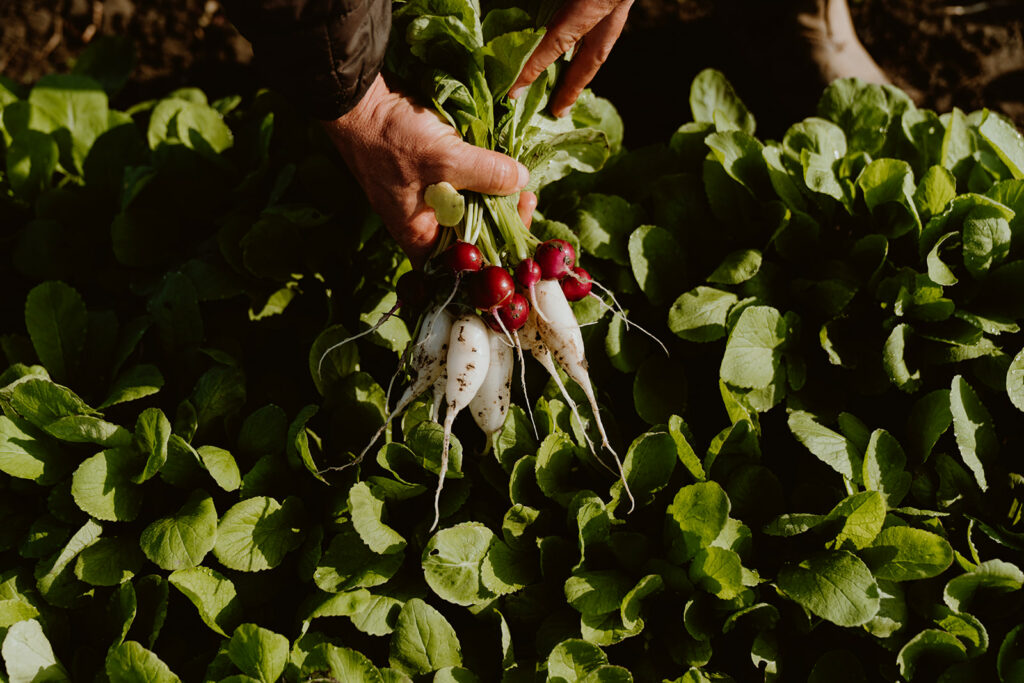
This spicy-sweet brassica boasts a surprising range, with a wide spectrum of shapes, colors, flavors, and growing seasons. It plays a role in traditional food cultures around the world, from Japan to Mexico to France.
SEASONAL IN SOUTHERN CALIFORNIA
PLANT: January through December
HARVEST: January through December
HISTORY
The radish is believed to have been domesticated in Central Asia around the 3rd century BC and spread quickly to Europe and later the Americas. It has played a role in food cultures throughout time, from the Egyptian laborers who built the pyramids being paid in radishes, to the people of Oaxaca, Mexico who still celebrate a holiday known as Night of the Radishes.
NUTRITION
Radishes are a rich source of vitamins C and B6, potassium and calcium, as well as trace minerals such as magnesium and copper.
STORAGE
Snip off leaves about ¼ inch from the top of the radish, clean off any soil, wrap in a cloth or paper towel, and store in an unsealed bag or container in the refrigerator crisper for up to 2 weeks.
PREPARATION
The raw radish can be julienned or shaved as a topping for tacos, added to slaws, or fermented with rice vinegar and soy for an Asian pickle. Radishes can be roasted, braised, or even halved and added to the grill—the smoky char adds a wonderful dimension to their spicy flavor. Radish leaves add a kick to any salad or sauteed greens.
COOKING
Thinly slice or shave radishes, and toss with a mixture of shredded cabbage and cilantro. Add lime juice, olive oil, and salt, and allow to marinate. Serve alongside enchiladas or barbacoa, or add avocado chunks and toasted pepitas for a delicious salad.
PRO TIPS
Most of the radish’s spicy flavor is concentrated in the skin. Leave on to enjoy the tangy kick, or for a mellower flavor, simply peel before cooking or eating. Larger radishes can sometimes have a bitter flavor—remove by salting and letting them sit for a while before serving.
Rosemary
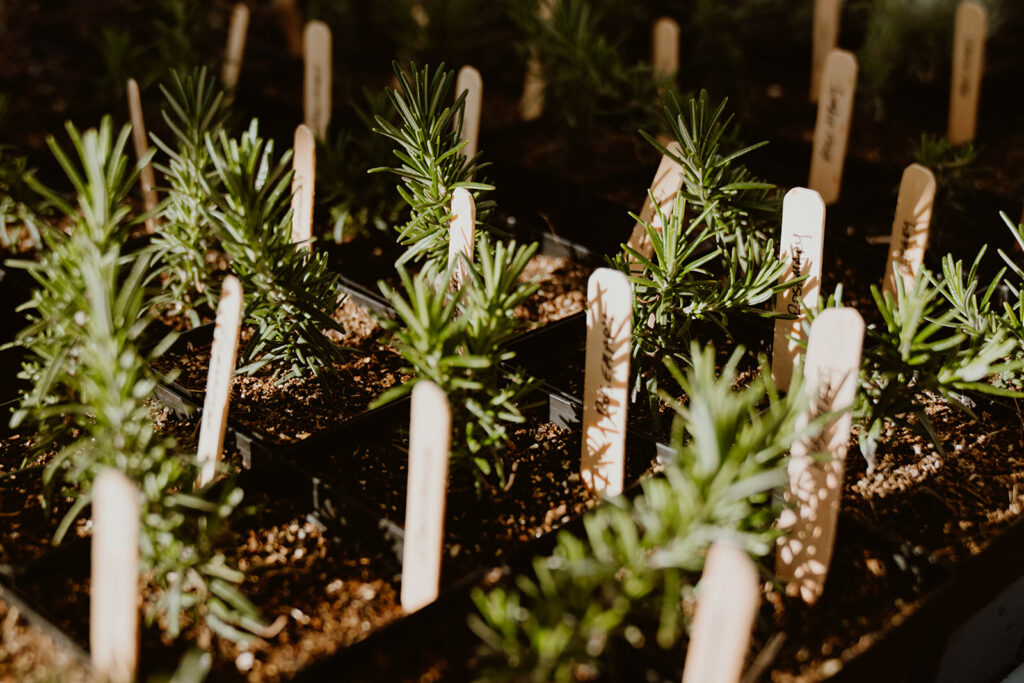
Rosemary is a small evergreen plant of the mint family, native to the dry, rocky areas of the Mediterranean coast.
SEASONAL IN SOUTHERN CALIFORNIA
PLANT: January through May
HARVEST: November through May
HISTORY
Rosemary’s name derives from Latin words meaning “dew of the sea.” Used in cooking since the time of the early Greeks and Romans, rosemary also symbolized love and remembrance. Rosemary was gifted to the queen of England in the 14th century by a Dutch countess, and was brought to North America by early European settlers.
NUTRITION
Along with being a rich source of antioxidant, antibacterial and anti-inflammatory compounds, rosemary is a cognitive stimulant, aiding with focus and memory. Rosemary is often used for digestion problems such as heartburn, liver and gallbladder complaints, and loss of appetite.
STORAGE
Wrap rosemary sprigs in a damp paper towel, seal in a plastic bag or jar, and keep in the refrigerator crisper for up to 3 weeks.
PREPARATION
Rosemary is well suited to seasoning simple, hearty soups and stews. Its flavor compliments pork, game, beef and lamb. It also goes well with the earthy flavors of grains, mushrooms, and root vegetables.
PRO TIPS
If not using a whole sprig of rosemary, separate leaves from stem and chop finely to use. 1 tablespoon of fresh rosemary substitutes for 1 teaspoon dried.
Sage
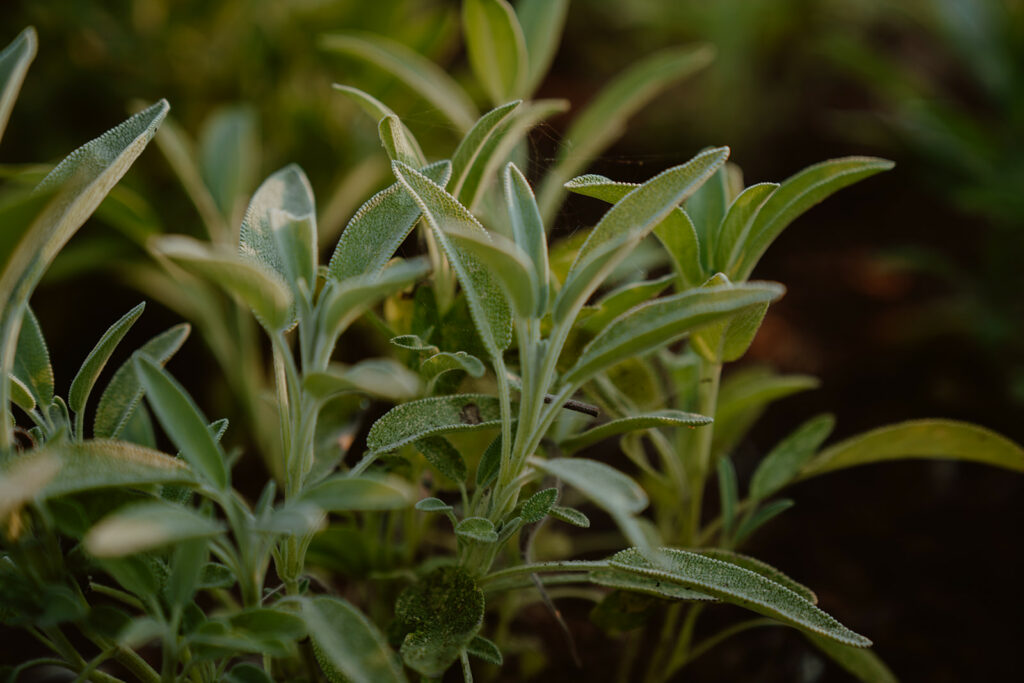
Native to the Mediterranean coast, common sage is named for from the Latin word meaning “to be saved,” thanks to its reputation as a medicinal cure-all.
SEASONAL IN SOUTHERN CALIFORNIA
PLANT: January through May
HARVEST: January through December
HISTORY
Ancient Egyptians used sage to stimulate fertility and to treat infectious diseases; it was also the main ingredient used in embalming. The Greeks and Romans used sage medicinally to enhance memory, while in the kitchen it was used as a meat preservative. The ancient Chinese eagerly adopted the use of sage and traded four pounds of tea for every one pound of sage. Today, there are over 700 species of sage spread throughout the world.
NUTRITION
Sage is high in vitamins A, C, E, and K and is a good source of folate, calcium, iron, magnesium, and manganese. It has shown promise in treating Alzheimer’s disease, cardiovascular disease, depression, and menopause symptoms. Its antiseptic properties can also help heal a sore throat, canker sores, gum disease, and fungal infections.
STORAGE
Wrap sage sprigs in a damp paper towel, seal in a plastic bag or jar and keep in the refrigerator crisper for up to 5 days. Alternatively, cover leaves with olive oil and store them in the refrigerator for about 3 weeks.
PREPARATION
With a dusky, dry flavor that complements meat and poultry, sage is a regular addition to traditional stuffing, as well as classic soup, stew, and sauce recipes. Sage leaves fried in butter are a delicious garnish for seafood and pasta.
PRO TIPS
If not using a whole sprig of sage, separate leaves from the stem and chop finely to use. 1 tablespoon of fresh sage substitutes for 1 teaspoon dried.
Spinach
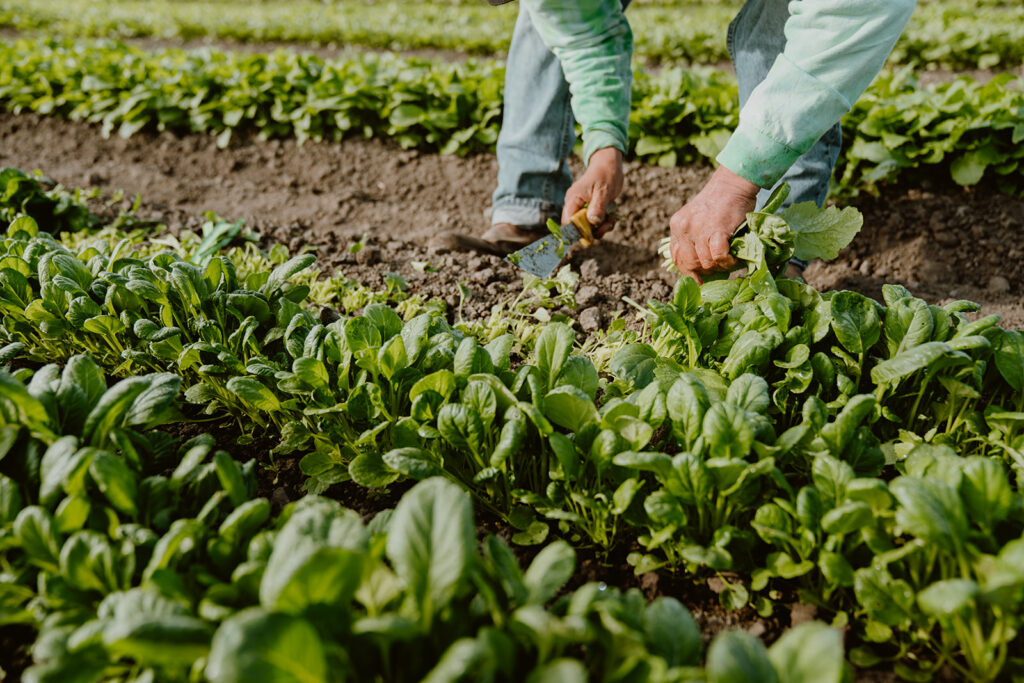
Beloved for its juicy sweetness and high nutrition content, spinach is the rare green that doesn’t feature any bitter taste.
SEASONAL IN SOUTHERN CALIFORNIA
PLANT: October through June
HARVEST: October through June
HISTORY
Spinach is believed to have originated about 2000 years ago in ancient Persia. It was introduced to China in the 7th century as a gift from the king of Nepal, and spread from there to India and the Middle East. Two hundred years later, Middle Eastern explorers introduced spinach to Europe. Its popularity skyrocketed during the Renaissance, thanks to Catherine de Medici, queen of Florence’s ruling family. Thanks to her love for spinach, dishes that include the vegetable are frequently said to be prepared “à la Florentine.”
NUTRITION
Spinach is legendary for being extremely nutrient-rich. Its dense mineral profile includes iron, potassium, magnesium, and calcium, and it has high concentration of vitamins B6, B9, C, E and K.
STORAGE
Thoroughly rinse spinach leaves and spread to dry on a towel (or spin in a salad spinner). When very dry, pack loosely in a plastic bag with a paper towel inside to absorb moisture. Spinach will stay fresh up to a week, but make sure to check every few days to remove any wilting or rotten leaves.
PREPARATION
Spinach’s natural sweetness makes it an easy addition to just about any recipe. Toss a handful of torn spinach leaves into soups, stews, pasta sauces, even smoothies or juices for an extra kick of nutrition. Cooked spinach can be added to egg dishes, grain bowls, bean dishes, or dips, or stuffed into meat or fish.
COOKING
Fry chopped garlic cloves in olive oil, then stir in a heaping spoonful of smoked Spanish paprika. Add several handfuls of fresh spinach leaves and a small amount of water, and cook until water is absorbed and spinach is wilted. Add a handful or two of cooked chickpeas, season with salt and additional paprika, and stir until heated through. Serve with more olive oil and crusty bread.
PRO TIPS
No need to remove spinach stems—they are tender and soften easily when cooking. They are also good for your health, with an extra dose of vitamins and minerals.
Strawberry
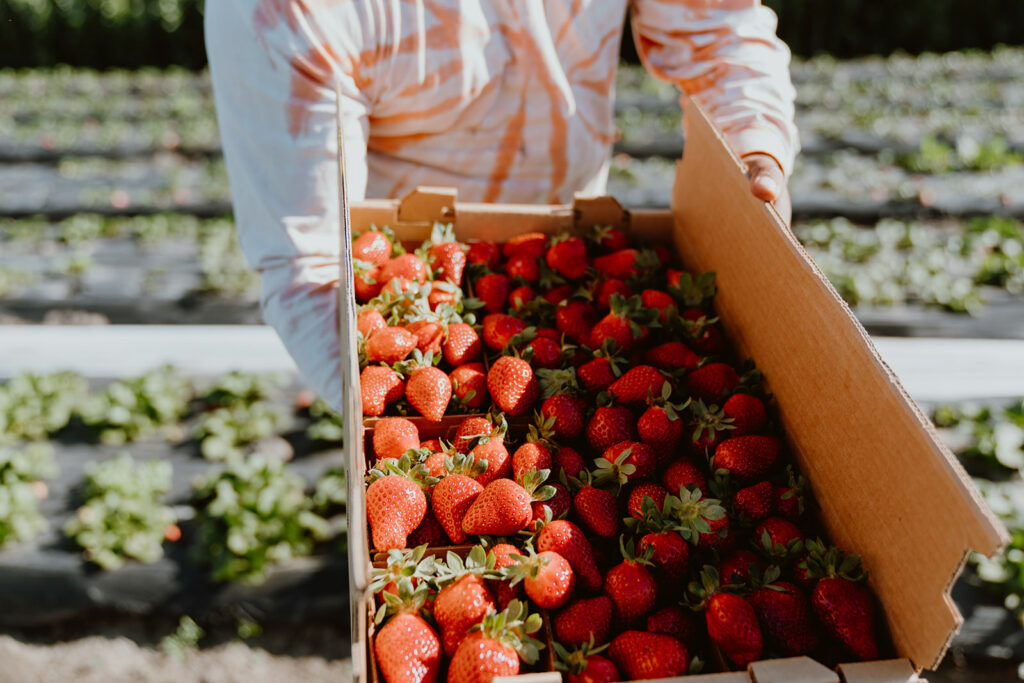
Possibly the world’s most popular berry, strawberries are an unmistakable sign that spring has arrived. While many mass-produced strawberry varieties are bred for texture and size over taste, organically grown strawberries preserve the delicate wild sweetness that makes these springtime treats legendary.
SEASONAL IN SOUTHERN CALIFORNIA
PLANT: January through March
HARVEST: April through July
HISTORY
Humans have enjoyed wild strawberries for millennia but did not begin cultivating them until relatively recently. Around the 14th century, it was common practice to forage wild strawberry plants from the forest and replant in a kitchen garden—one French king collected 1,200 wild plants for his royal garden. By the 17th century, several European subspecies had been crossed, and with the addition of a female-flowering species brought back from South America, the modern strawberry was born. The first fully domesticated strawberry was farmed in northern France at the end of the 18th century.
NUTRITION
The ancient Romans consumed wild strawberries (the leaves and stems as well as the fruits) to cure depression; crushed strawberries mixed with salt were also a folk remedy to heal blisters and wounds. In the 18th century Europe, strawberries were considered to heal kidney stones, gout, and even summer colds; today’s science bears this out, with evidence supporting the ability of strawberries to help reduce cholesterol, blood pressure, and inflammation, and prevent blood sugar and insulin spikes.
STORAGE
In general, it’s best to leave berries unwashed until just before using. That said, if you plan to save the strawberries for more than a couple of days, it can help to wash them in a vinegar bath to kill any spores on the fruit. Submerge strawberries in a cold bath of 1 part white vinegar to 8 parts water, leave for no more than 5 minutes, then spread out between two towels, and let air-dry completely before returning to the refrigerator.
PREPARATION
Before using in a recipe, pick through strawberries and remove any that have gone extra soft (unless you plan to puree them in a soup or sauce). Rinse strawberries in cold water, then remove the hulls with the end of a knife or by simply pinching off the green stem with your fingers.
COOKING
Strawberry desserts are found in cultural foodways across the globe, from English/American strawberry shortcake and Swedish Midsummer cake to Mexican fresas con crema and Chinese tanghulu. But strawberries offer a sweet overtone to a variety of savory dishes, pairing well with ingredients like pork, fennel, spinach, spicy peppers, feta or goat cheese, and fresh herbs like basil, tarragon or sage. Try adding strawberries to salsa, gazpacho, or teriyaki sauce, or simmering with peppercorns in red wine or balsamic vinegar for an all-purpose seasonal condiment to use over meat. Combine halved strawberries with torn basil and slices of Brie for a new take on the Caprese salad, or layer with Prosciutto, ricotta and fines herbs on toasted bread for a sweet-savory crostini.
PRO TIPS
To freeze fresh strawberries, rinse, hull, and slice strawberries in half. (Smaller berries can be left whole.) Place strawberries on a baking sheet lined with parchment paper, ensuring the berries do not touch each other. Place the baking sheet of strawberries in your freezer for 2 to 3 hours, removing when partially frozen. Transfer to a resealable bag, press out as much air as possible, and return bag to the freezer. Frozen strawberries will keep for up to 1 year.
Summer Squash
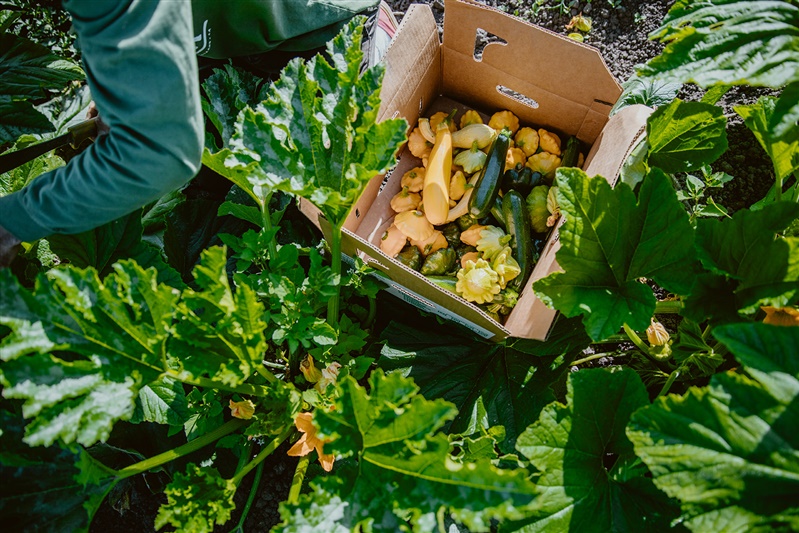
Summer squash refers to a squash harvested before it is fully mature, while the rind is still thin and soft. The name refers not to when they are harvested, but to their shorter storage life compared to winter squash.
SEASONAL IN SOUTHERN CALIFORNIA
PLANT: February through September
HARVEST: May through October
HISTORY
Historians believe that squash is North America’s oldest cultivated food, predating even corn and beans, the other crops included in the traditional “Three Sisters” companion growing method. A mainstay of the indigenous North American diet, the squash, along with its blossoms and seeds, were eaten at all levels of ripeness, and even dried in strips for long journeys. Explorers’ logs from the 17th to the 19th centuries make mention of squash being eaten by indigenous people from the northeast to the western edge of the Great Plains. Summer squashes were brought to Europe as early as 1590, and were readily adopted by colonial American farmers as well.
NUTRITION
Summer squash is a good source of vitamins A, B6, C and K, phosphorus, folate, magnesium, and potassium.
STORAGE
Gently wipe any dirt from summer squash, then store in an unsealed or perforated plastic bag in refrigerator crisper for up to 4 days.
PREPARATION
Summer squash has a firm yet tender texture and a mild, cucumber-like flavor that adapt well to all kinds of preparation. Raw summer squash can be sliced thinly and marinated as a vegetarian carpaccio, or spiralized into noodles and eaten like cold pasta. Summer squash pairs beautifully with other summer vegetables such as tomatoes and eggplant in sautés, terrines, and stews, as well as baking with a savory filling or grilling. A favorite preparation is shredding squash and combining with onions, eggs and flour as fritters, or coating in batter and frying into tempura.
COOKING
Cut summer squash into small chunks and toss with kosher salt; place in colander and allow to drain for at least 30 minutes. Pat dry, then add in a single layer to a hot, oiled frying pan. Brown for at least 5 minutes, then reduce heat, cover pan, and let cook until tender. Remove and toss with additional olive oil, garlic, vinegar, sugar, red pepper flakes, and chopped herbs. Let marinate for at least another 15 minutes. Serve over crusty bread spread with ricotta cheese, topped with toasted pine nuts.
PRO TIPS
A common complaint is that summer squash ends up too watery when cooked. There are two solutions. First, salt the squash and let drain for at least 30 minutes before using. Second, cut squash into larger pieces before cooking.
Tarragon
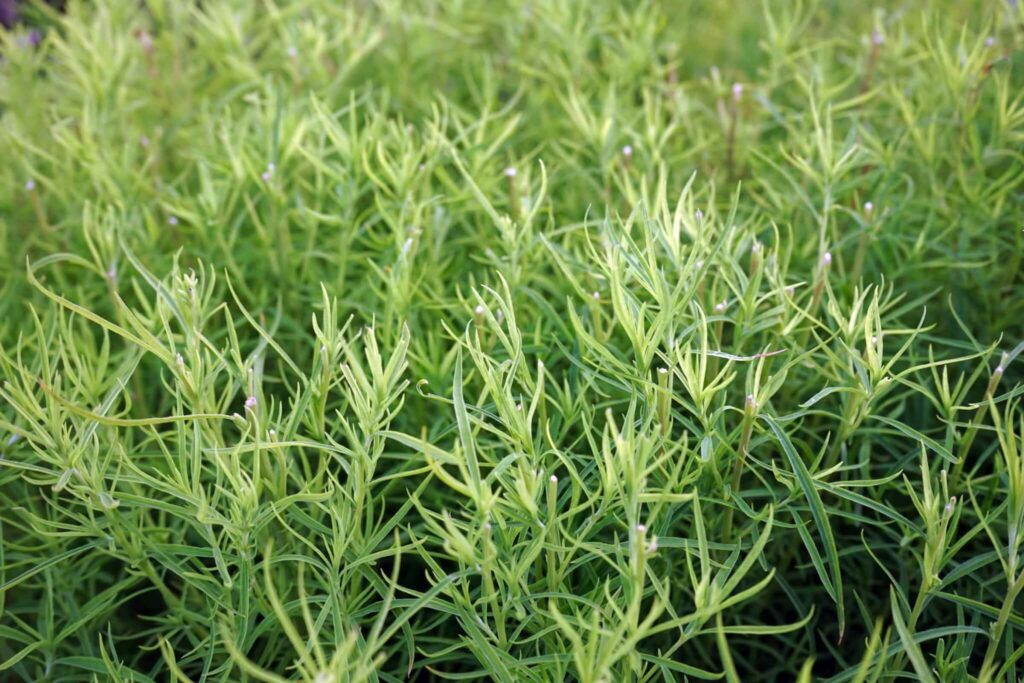
Tarragon is a perennial herb native to Siberia, with a strong anise-like flavor (their oils are chemically identical). Its name is derived from a Latin word meaning “little dragon,” thanks to its twisting roots, and it was traditionally believed to cure dragon bites as well as insomnia and bad breath.
SEASONAL IN SOUTHERN CALIFORNIA
PLANT: January through May
HARVEST: January through December
HISTORY
Tarragon is a fairly “young” herb, having only been cultivated for around 600 years. It is believed that invading Mongols brought tarragon to Italy sometime in the 10th century. In the 14th century, St. Catherine carried tarragon with her on a pilgrimage to France, where it is principally used today. celebrate a holiday known as Night of the Radishes.
NUTRITION
Tarragon is a good source of vitamins A, B6, and C, as well as folate, calcium, iron, magnesium, potassium, and manganese. Tarragon has been traditionally used to treat poor digestion, intestinal problems, rheumatism, gout, arthritis, and toothache.
STORAGE
Wrap tarragon sprigs in a damp paper towel, seal in a plastic bag or jar and keep in the refrigerator crisper for up to 3 weeks.
PREPARATION
Tarragon is a key herb in French cooking and is included with chervil, chives, and parsley under the term fines herbs.It is the main flavoring in béarnaise sauce, features in a number of Eastern European recipes, and is a principal herb in Persian-style pickles. Tarragon goes well with poultry, fish, and egg dishes, and is complemented by acidic flavors in citrus and vinegar, making it a popular addition to salad dressings and marinades.
PRO TIPS
If not using a whole sprig of tarragon, separate leaves from the stem and chop finely to use. 1 tablespoon of fresh tarragon substitutes for 1 teaspoon dried.
Thyme
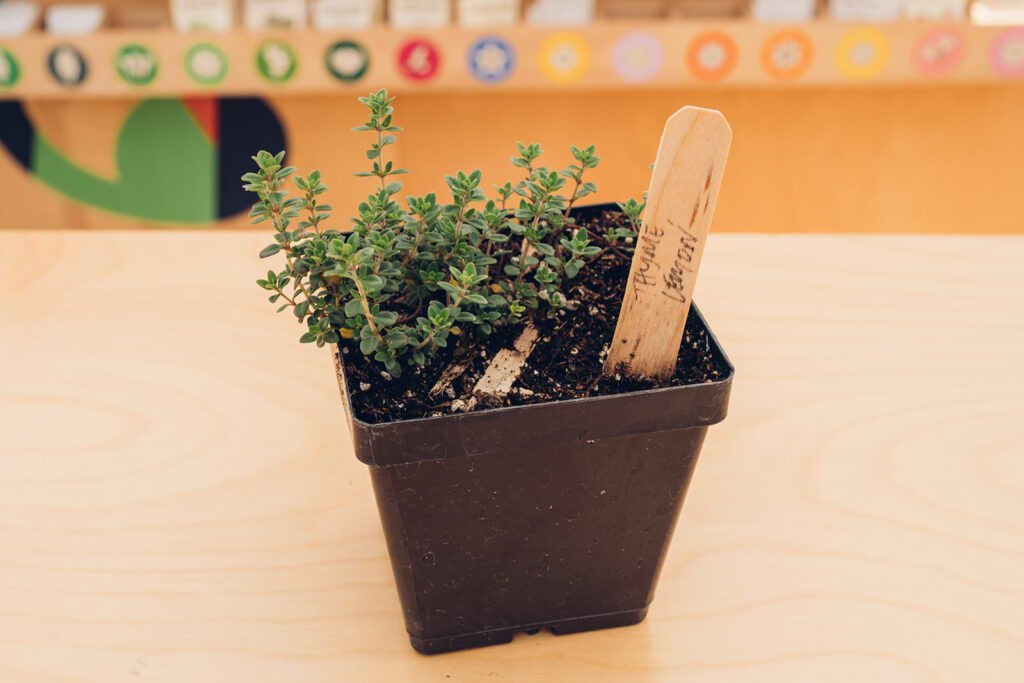
A member of the mint family with small curling leaves, thyme is native to the southern Mediterranean region. Its antimicrobial properties have led to its long use as a food preservative, as well as a healing and purifying medicinal herb.
SEASONAL IN SOUTHERN CALIFORNIA
PLANT: January through May
HARVEST: January through December
HISTORY
Thyme was used as an embalming ingredient by the ancient Egyptians, and bundles of thyme were traditionally burned by ancient Greeks and Romans to purify both homes and temples. The Romans also ate thyme sprigs before and after a meal, believing it to be an antidote to poison. This tradition continued with medicinal potions made from thyme used to combat the Black Death in the 1340s. Even in the 19th century, nurses soaked bandages in thyme-infused water. Throughout history, thyme was also used in baking, cooking and food preservation to help protect against spoilage and foodborne disease.
NUTRITION
Along with nutrients such as vitamins A and C, potassium, and magnesium, thyme is known for containing a powerful antiseptic known as thymol, a common ingredient in mouthwash, hand sanitizer and acne medication.
STORAGE
Stand thyme sprigs in a jar with 1 to 2 inches of water, and keep for up to 3 weeks. Alternatively, wrap thyme sprigs in a damp paper towel, seal in a plastic bag or jar, and keep in the refrigerator crisper for up to 1 week.
PREPARATION
With its deep, pungent flavor, thyme is part of the traditional French bouquet garni used to flavor stock and soups, as well as the Middle Eastern spice mix za’atar. Another popular use of thyme is infusing it into oil or butter and using to baste meat, poultry or fish while roasting or grilling. It offers warm, earthy flavor to grains and legumes, as well as marinades and vinaigrettes, and is a tasty addition when sprinkled onto garlic bread. It also pairs well with sweet flavors, and can be infused into jellies or syrups for use in dessert or cocktails.
PRO TIPS
If not using a whole sprig of thyme, separate leaves from stem and chop finely to use. 1 tablespoon of fresh thyme substitutes for 1 teaspoon dried.
Winter Squash
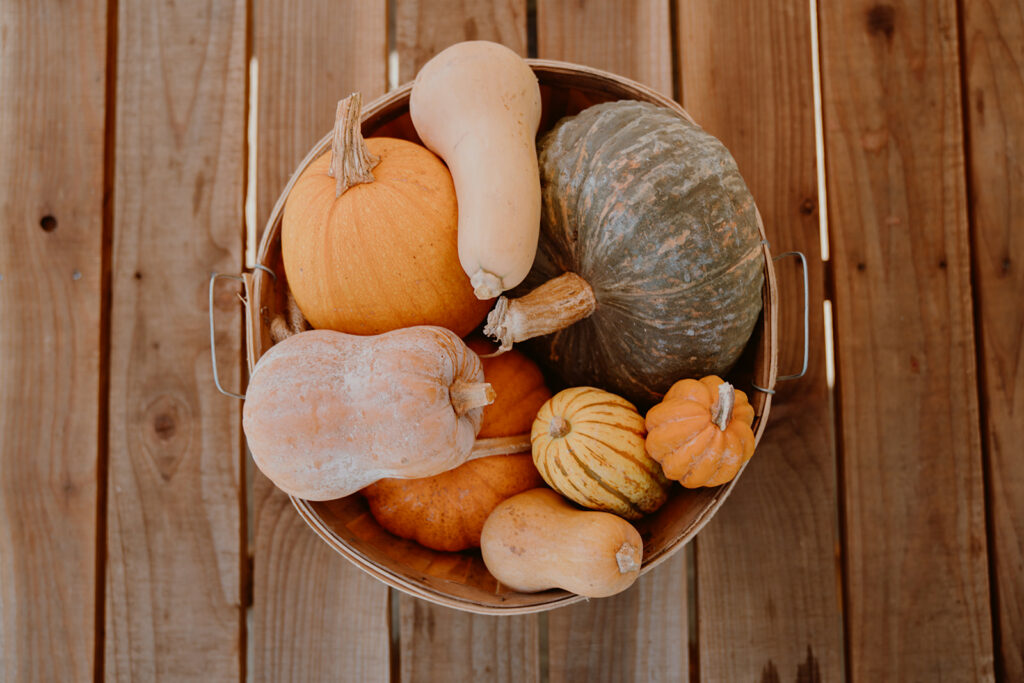
This hard-shelled vining fruit is a mainstay of indigenous American foodways. Beloved today for its sweet taste, soft texture and filling nutrition, winter squash was traditionally consumed in its entirety, with flesh and seeds roasted for food, and shells dried out for use as containers and water vessels.
SEASONAL IN SOUTHERN CALIFORNIA
PLANT: July through May
HARVEST: October through June
HISTORY
Native to Mexico and Central America, winter squash were used to pioneer the method of “companion planting,” in which crops were planted in pairs to contribute to each other’s growth. In the American southwest, winter squash, corn and beans were known as the Three Sisters, and planted in a system known as the milpa. Carried across the Atlantic by European invaders, winter squash was embraced by people around the Mediterranean Basin, and eventually carried to Asia by Portuguese traders in the 16th century.
NUTRITION
supplied beta carotene, Omega 3’s and Potassium
STORAGE
Unpeeled, uncut winter squash can be kept for up to 3 months in a cool, dark, well-ventilated location. Cut and peeled squash can be kept in a sealed plastic bags in the refrigerator crisper for up to 5 days.
PREPARATION
Winter squash is one of the easiest vegetables to prepare: simply slice in half, remove seeds, and roast at high heat until flesh is soft enough to scrape out of the skin. Squash can also be peeled and cubed before being cooked. Starchy varieties like kabocha and kuri are best for frying and baking, while dense varieties such as pumpkin and acorn squash are better for baking or steaming, and the softer butternut and delicata are ideal for purées, soups, stews and curries.
COOKING
Cut winter squash down the middle, remove seeds, and roast at 450 for about 60 minutes, or until squash can be easily pierced with a fork. Let cool slightly and scoop flesh out of skin. Add cooked squash to a high-speed blender with sautéed onions and garlic, a whole apple (seeds removed), and enough vegetable broth to barely cover. Add your favorite spices such as curry and garam masala, cumin and chile, or cinnamon, nutmeg and pepper. Add a dash of cream or coconut milk, if desired. Process in a blender until mixture is thick and smooth. Add salt and pepper to taste, and serve topped with roasted squash seeds.
PRO TIPS
Winter squash seeds can be easily removed using a melon baller or ice cream scoop in place of a spoon.


